The Hardwax Oil Experiment – Part 4 Pallmann Magic Oil
So here we are 4 months into our Hardwax Oil Experiment. This is our final test subject – Pallmann Magic Oil. For the last 3 months we have extensively tested and reviewed OSMO Oil, Rubio Monocoat and Bona Indoor Oil. After our not so great outcome last month with Bona’s product, we’re happy to report that this hardwax oil did way better!

Unlike Rubio Monocoat and OSMO, most people will probably not have heard very much about Pallmann Magic Oil. In fact getting any consumer information about it can be very difficult because the distributor in the States doesn’t market anywhere near as well as the other two hardwax oil distributors.
But if you’ve browsed through our website you’ve probably noticed that we’re HUGE fans of Pallmann’s water-based finishes.
In fact for water-based finish systems we exclusively use their Pall-X Power single component system and Pall-X Gold, their high-end 2 component system. Both of these finishes are amongst the best of the best and we wholeheartedly recommend them to our clients. (You can read more about these finishes here.)
So the pressure was on for Pallmann to prove to us that their hardwax oil is as good as the water-based line-up. To say we had very high expectations going into this experiment is an understatement.
Let’s see what Pallmann have to say in their limited Magic Oil marketing materials…
Pallmann Magic Oil Features:
- Made from a hybrid of natural oils and waxes
- Environmentally friendly with extremely low VOC’s
- Comes in 6 colors (unlimited colors if you stain first and use Neutral)
- Easy to look after, clean and maintain
- Easily spot-repaired
- Uniform matte, velvety surface that repels dirt and water
- Enhances the beauty of your woods natural grain
- Great chemical resistant properties and non-flammable
- Rated for use on radiant heat floor systems
- Rapid drying properties allow for refinishing to be completed quickly
- Two component system
Pallmann Magic Oil Benefits:
- The non-toxic natural oils and waxes makes it a very environmentally and family friendly finish to use
- Because there’s very low VOC’s and no solvents you won’t be driven out of your home by horrible fumes
- Scratches and damage can be easily spot repaired without having to re-coat the entire room to match the sheen
- It won’t off-gas bad fumes, chemicals and smells for weeks after it’s applied
- Doesn’t form a plastic film like other varnish, acrylic and polyurethane finishes
- It’s a two component finish which makes it durable enough to be used in commercial applications as well as residential projects
- Because you can stain the floor first and then top coat it with the Neutral color, you have pretty much unlimited color choices
Sounds pretty impressive doesn’t it?
Let’s see how this finish held up to our real world testing…
STEP 1 to our Pallmann Magic Oil Review:
Like all the other finishes we’ve tried out and tested, we started out in our shop on test panels. (We never, ever practice or experiment with new products on our clients floors.)
The oiling application went well and the dry time matched what was advertised – 4 hours till it can be walked on and overnight to cure. We experimented with different liquids and it stood up to them extremely well. We were also impressed with how durable it was as we scratched them up and banged them around with various instruments.
So step one was easily passed, onto the next stage…
STEP 2:
This is when we get to test it out on a real world floor. Like in our OSMO experiment, our good friend Arvydas from Arch Remodeling (you can see a few of our projects with him on our Photo’s page) stepped in with a cool project that needed the hardwood floor refinished.
Arvydas is a very creative contractor and like us he’s eager to try out the latest products. This project was pretty special to him because they were his own floors.
As usual, he went way beyond installing boring conventional store bought flooring.
He had found some antique reclaimed timber that he had custom milled into floor boards of various widths. These boards were full of rustic character and the milling added even more. To make the floor even more interesting he installed cross-cut log inserts throughout the floor.
We took great care to keep all the saw blade marks, worm holes, hand-scrapping and other cool looking character on the floor as we carefully sanded it.
No big belt sander on this unique floor.
Take a look at how it turned out…

In the picture above we’re buffing off the excess oil from the first coat of Magic Oil.
The shot below shows us finishing off the last coat.
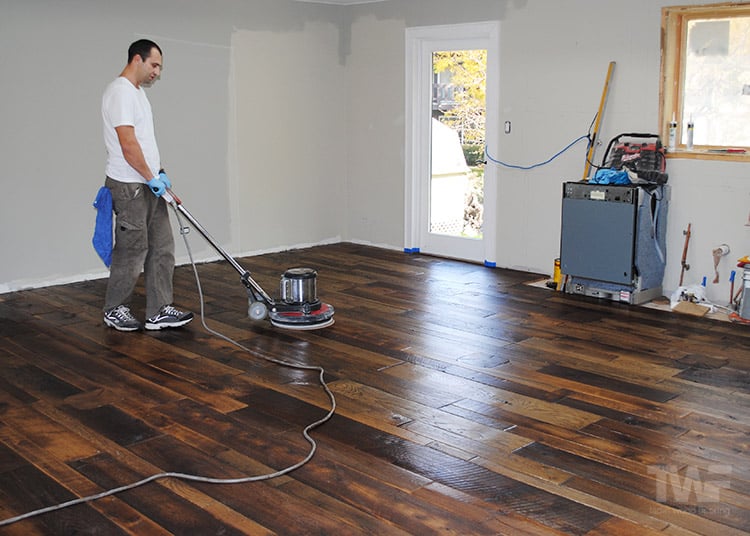
Here’s a close up of the floor.
Isn’t it beautiful? I love all the character in it with the saw blade marks and the checks and other imperfections. It looks like it’s been there for a hundred years, not just a few days…
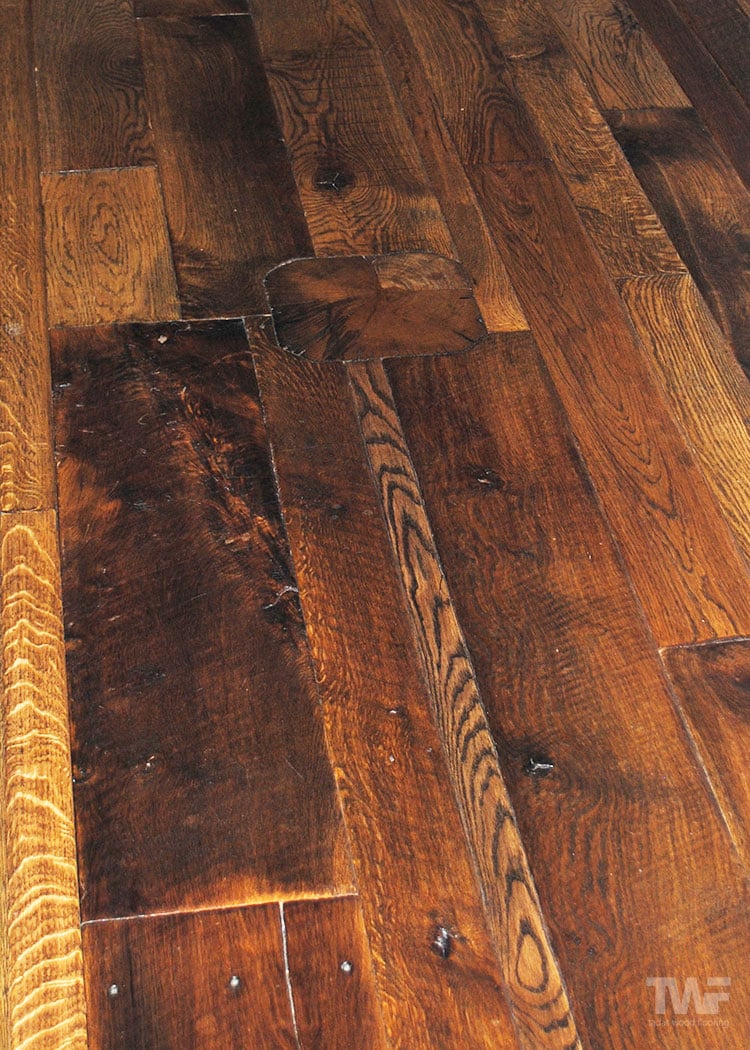
This photo was taken after all the renovations were completed…

…and another to show richness and the nice sheen this hardwax oil has.
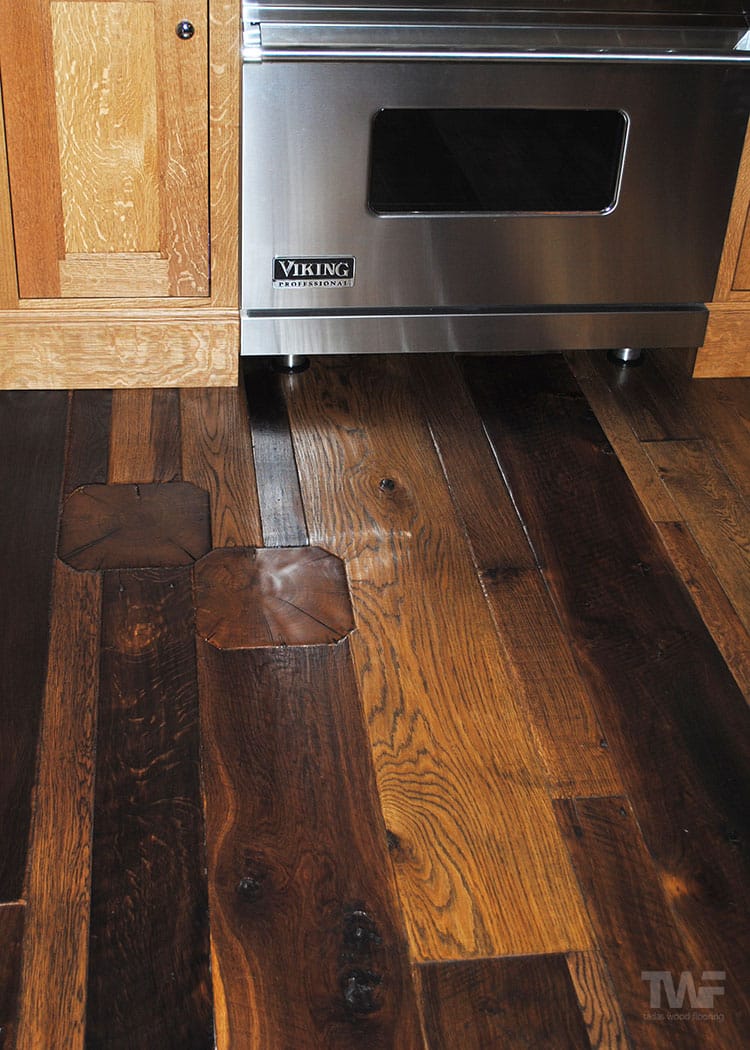
And lastly, here’s one of the stairs. Again you can see the nice velvety sheen on the tops of the treads…
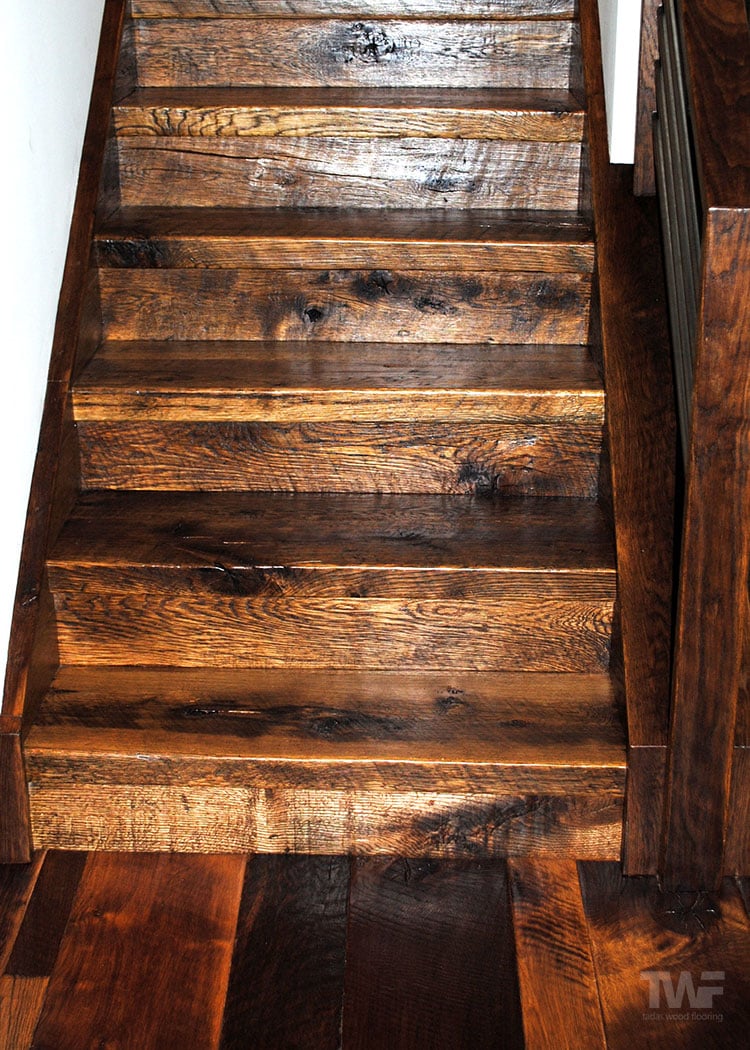
This was a pretty special floor and we really enjoyed working on it.
The next project we had the pleasure of using this hardwax oil on was in Darien, Illinois. It’s a Lithuanian café/gift shop/deli called Old Vilnius Café.
This place used to be a hardwood and carpet showroom before it was transformed into a café. Ironic hey.
Because of the commercial nature of these floors, this would be the perfect place to see how well these floors stand up over time with all the traffic that would make its way through the store on a daily basis.
Here are some pictures of the floors…
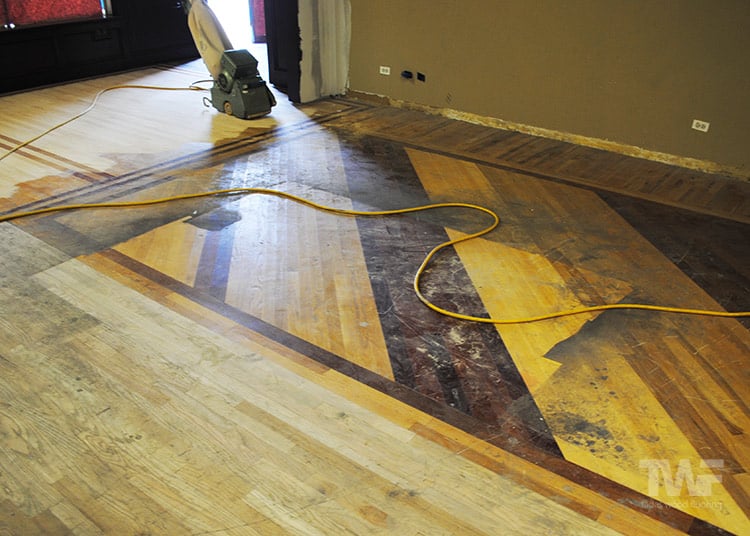
The photo above shows us starting the sanding process by removing the old polyurethane finish. Because it was a previous flooring showroom there were a few different species of wood and various patterns in the floor.
In the picture below we’re finishing up staining and are getting ready to apply the Magic Oil…
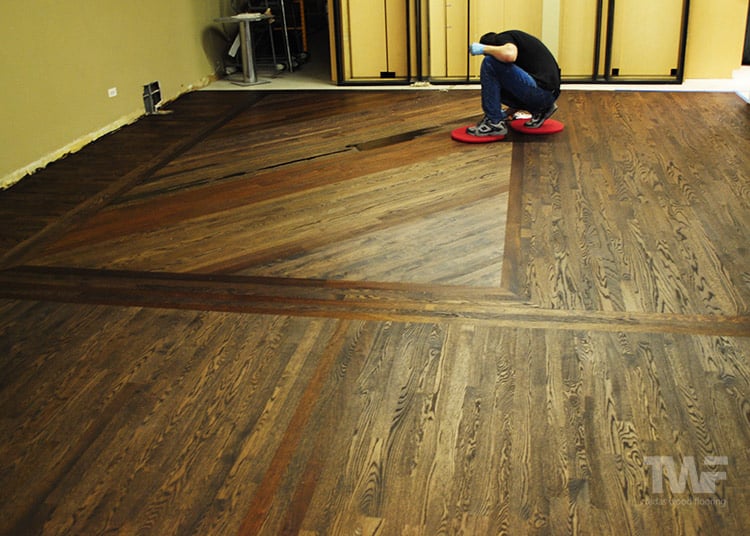
And here is the project all finished up…
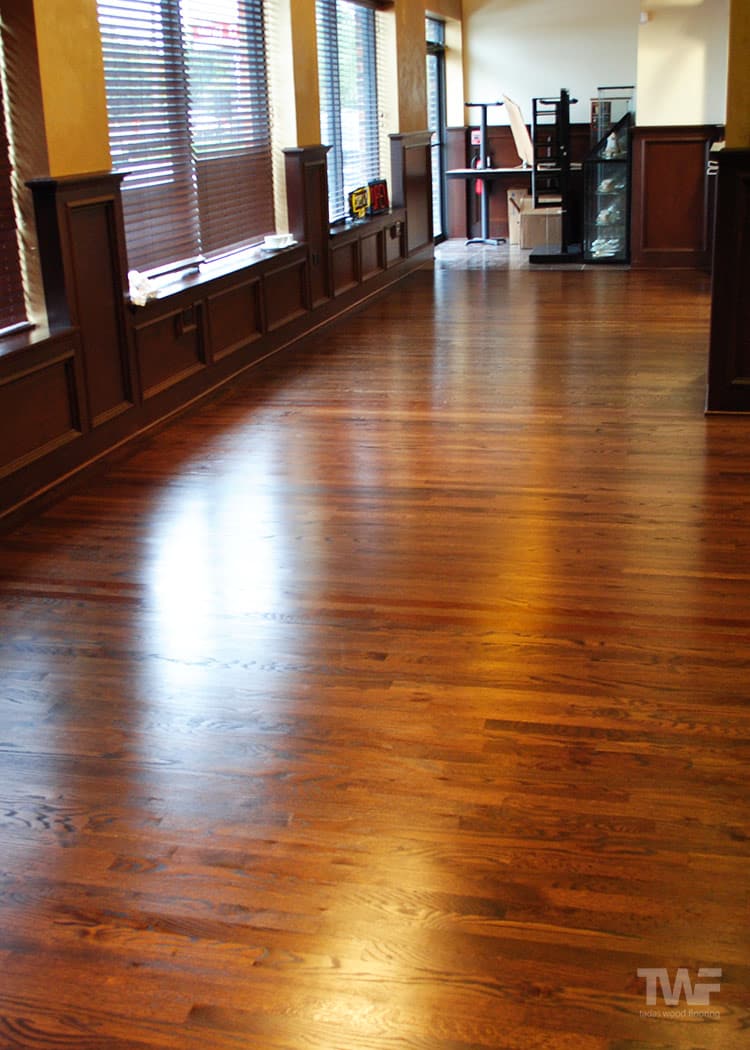
Shot from another angle…
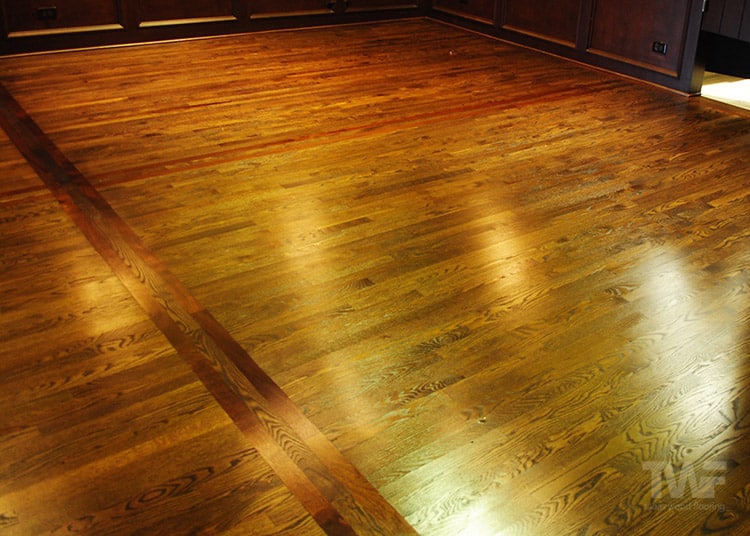
This is what it looks like with all the shop fittings in place open for business…
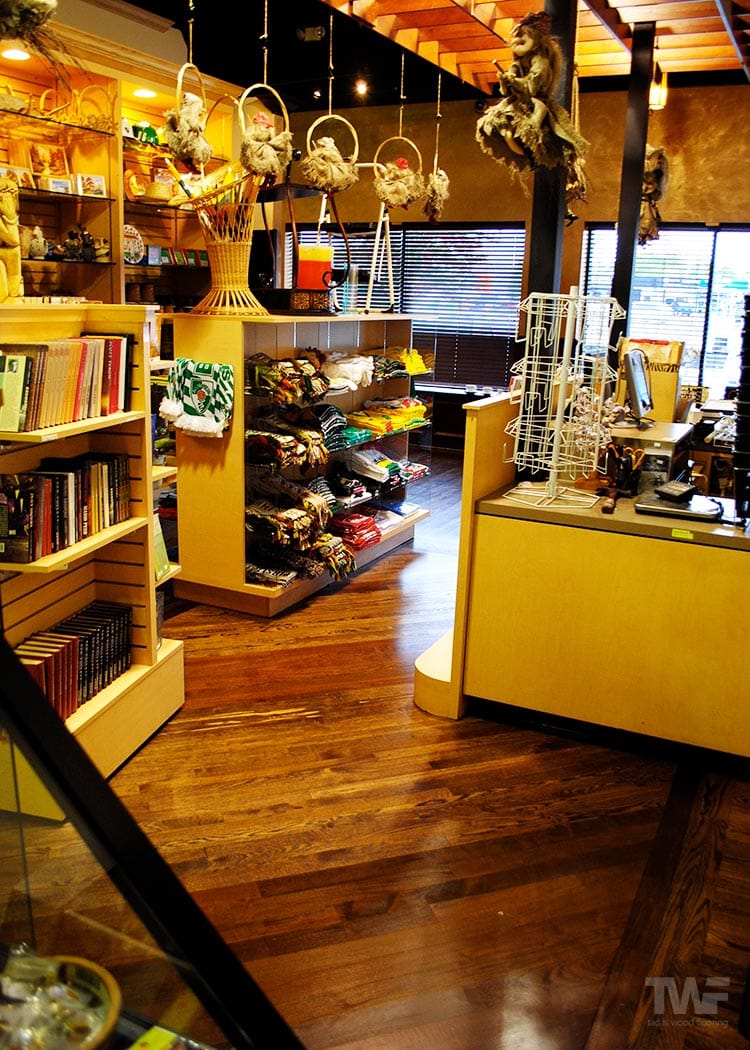
So what do we think of this hardwax oil finish system after these two jobs?
Well let’s go back and review the basics of what we look for in a finish:
- Has to look good
- Must be long-lasting, durable to traffic and resistant to spills
- Have relative easy maintenance and repair
- Not “yellow” excessively over time
- Not have high VOC’s and stink up the home for days on end
- Not take forever to cure
So far both Rubio Monocoat and OSMO have passed these 6 requirements with flying colors. How did Pallmann’s Magic Oil fare?
Let’s see…
1. Good Looking:
What do you think from the pictures above?
Personally, we think Magic Oil is the best looking finish out of the 3 hardwax oils we’ve tested and used. It has a bit more sheen compared to the very matte Rubio Monocoat – but without the plastic coated look.
Like Pallmann promises, it looks very natural and really enhances the beauty of your timber’s natural grain. You can really see that in the first floor we finished above. The character just popped out and came alive when the Magic Oil was applied.
If you want more sheen, we can just buff it a bit more to polish it up. Of course it will never be high gloss or even semi-gloss, but if you’re after a deep, velvety matte look, then this hardwax oil really fits the bill.
As far as colors, it only comes in 7 including Neutral which is way under Monocoat’s 40+ basic colors and unlimited variations with the pre-treatments.
These are the 7 basic Magic Oil colors…
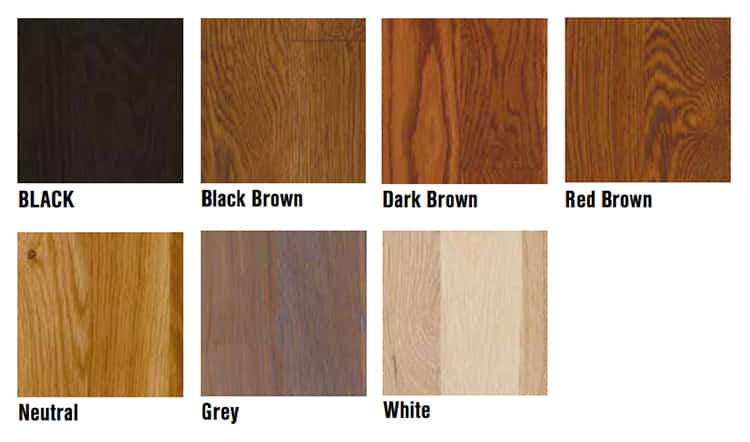
But those basic colors can be mixed together to come up with custom blends. These are some of the custom blend possibilities…

And on top of that, because Magic Oil is a 2 coat system, you can use one of the 7 colors as the base coat, and a different color (or color mix from above) for the second coat.
This opens up the possibility for all sorts of cool two tone color effects…
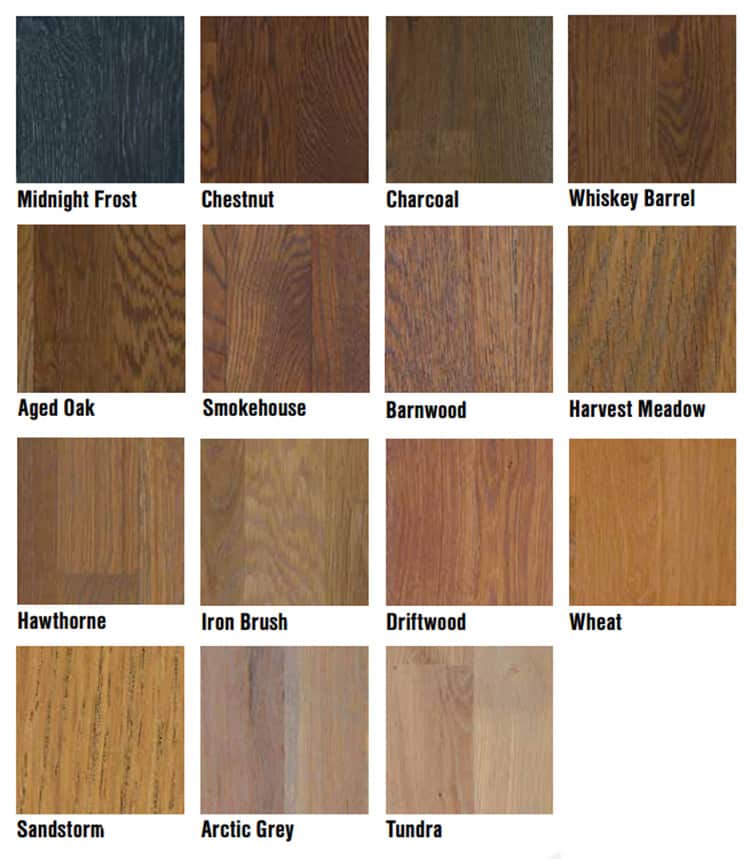
You can also use a stain underneath – like we did in the café above – to obtain any color you want and then top coat it with Neutral.
Here is a Sedona Red and Ebony 50 percent mixed stain with Neutral Magic Oil on top…
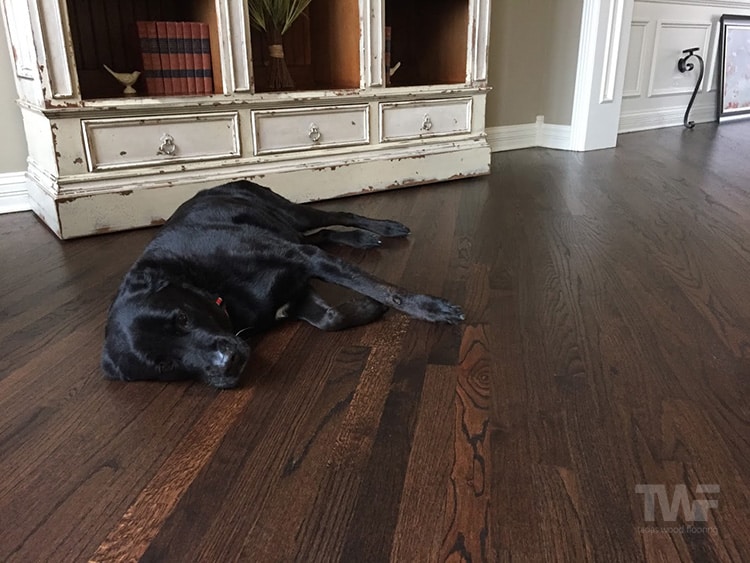
And this is DuraSeal Heritage Brown with Neutral Magic Oil…
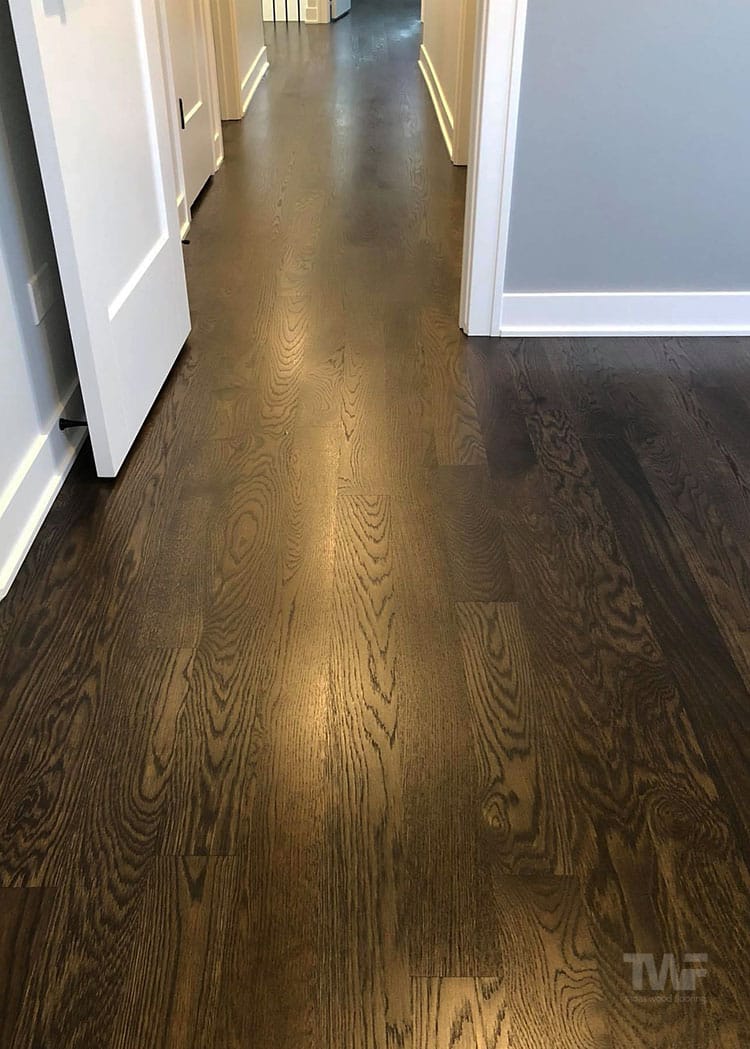
And this floor is stained DuraSeal Nutmeg before Neutral Magic Oil was applied on top…
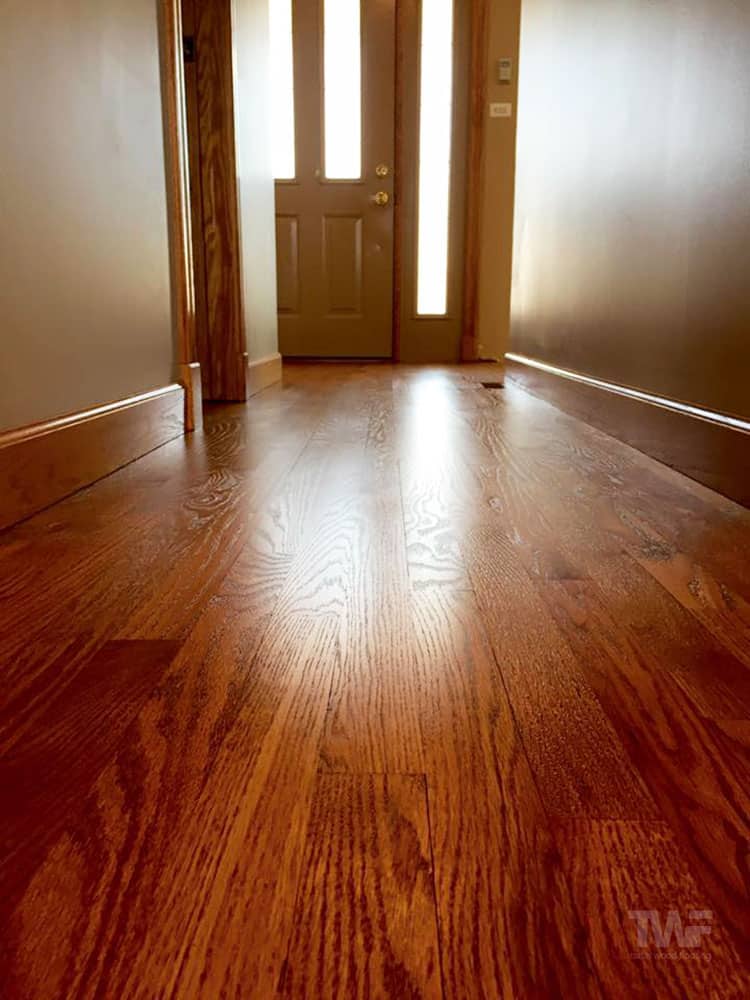
With the basic colors, the mixes and blends you can obtain from them, the option to use stains and pre-treatments – your color options really are unlimited.
2. Long-lasting, durable to traffic and resistant to spills:
Along with looks, this would have to be the biggest factor people are concerned about when they choose a finish system.
And for good reason too.
Nobody wants to invest a significant amount of money into restoring their hardwood floors and find out soon after that it’s not as durable or spill resistant as they thought it would be – as can be the case with cheap oil based and single component water based finishes. This is also a frequent complaint for those that use traditional penetrating oil finishes that need constant upkeep and re-oiling to keep their protection intact.
You need to be confident that spills and other mishaps can be cleaned up without leaving long-lasting damage, and that every day traffic and use won’t prematurely wear them down after a few months or years.
Pallmann Magic Oil does extremely well in this regard.
As it is a blend of wax and natural oils, the finish penetrates deeply into the pores of the wood as well as forming a durable protective surface on top. The nice thing though is that it’s not a thick plastic covering that mutes out the natural look and feel of the wood. And unlike cheap surface finishes, Magic Oil won’t crack, flake, blister or peel.
We were also very impressed with its resistance to all of our test liquids as well. None of them left any permanent damage on our test panels.
It’s a two component finish so it is very durable. If it’s used in a commercial application you can double the hardener for added strength. Our real life tests are still inconclusive (we need more time) but we’re pretty certain that it is most likely the toughest hardwax oil finish available. We’ll update this post when we’re absolutely certain.
Again we have to ask… is it as strong as our Pall-X96 and X98 finish systems?
And the answer is the same as the other two hardwax oils – No.
But… the great thing about these hardwax oils, including Magic Oil, is that if there is any surface damage done it can very easily be spot repaired – which brings us to the next point…
3. Easy Maintenance and Repair:
As we talked about in Part 1 and Part 2 of our Hardwax Oil Experiment, easy maintenance is one of the reasons “plastic” surface finishes have been so popular over the years compared to hard-to-maintain traditional penetrating oil systems.
Magic Oil won’t stain or watermark like traditional penetrating oil finishes yet it is also very easy to clean like a surface finish.
But as we also talked about in those two write-ups (sorry for some repetition here), the strength of this system is also its greatest weakness. These finishes are basically a big “plastic” sheet spread out across the entire floor and deep scratches are very hard to repair properly if you want to blend them and match the sheen in with the rest of the floor.
But hardwax oils – including Pallmann’s Magic Oil – really excel when it comes to repairability.
Sure they’re not as tough as a two component water-based finish system… but when they do get scratched or damaged they can easily be spot repaired and the area will seamlessly blend in with the rest of the floor.
This is because only the open (damaged) wood fibers will take the new oil. The existing finish next to the scratched or damaged area won’t accept new oil so there is no overlapping or additional buildup of finish.
This really is a huge feature.
If well looked after and properly maintained with Pallmann’s maintenance products – ‘Pallmann Hardwood Floor Cleaner’, ‘Magic Oil Care’ and ‘Magic Oil Clean N Prep’ – this finish system should last a lifetime and you will possibly never need to re-sand your floors ever again.

‘Pallmann Hardwood Floor Cleaner’ is for daily light cleaning. ‘Pallmann Magic Oil Care’ is a long term maintenance product that is used every 4 – 6 months and is just an easy application with a dampened microfiber mop. ‘Magic Oil Clean N Prep’ should be used every few years to remove any residue from the previous two cleaners before applying another coat of Magic Oil.
All of these can be done by the homeowner.
The ‘Magic Oil Clean N Prep’ process and re-application of Magic Oil that is suggested every couple of years can also be done by your hardwood floor guy to make it easier if you like. This process goes much faster with the right equipment.
All in all it’s far easier to look after compared to a traditional oil finish and much less hassle long-term to completely re-sanding and refinishing your entire hardwood floor every 7 to 10 years if you have a lower-end surface finish.
4. Non-Yellowing:
The natural oils and waxes used in the finish are non-yellowing so you don’t have to worry about that ugly old orange look that you can get with after a couple of years with polyurethane oil modified finishes.
5. VOC’s and Stink Factor:
VOC’s or Volatile Organic Compounds can be very harmful not only to the environment but also for your health. Lately governments have been trying to curb the usage of products with dangerous levels of VOC’s and have started to regulate the hardwood floor industry. Many businesses are finding themselves having to quickly become adept at using lower VOC finishes.
Thankfully we were ahead of the curve and have been using low VOC finishes for some time.
Our favorite waterborne finishes, Pall-X Power and Pall-X Gold are 180g/liter and 200g/liter in the VOC department. That is extremely low for a high-end finish. Most oil based finishes are way above 500g/liter and Glitsa is a whopping 725g/liter!
In contrast Pallmann Magic Oil in the Neutral color we used has less than 5g/liter. The colored versions have 9g/liter. That’s less than OSMO’s 50g and slightly more than Monocoat’s amazing zero grams per liter.
That makes it very environmentally friendly as well as family friendly.
The smell is just a mild vegetable oil like smell that will quickly dissipate with proper ventilation. It smells like you’re cooking fries in old oil. So if you need to stay at home during the finishing process, that won’t be a problem. This finish definitely won’t drive you out of your home like some of the crazy stinky ones out there.
6. Time to Cure:
Magic Oil is dry to the touch in 1/2 hour, able to be walked on in 4 hours and completely cured in 12 hours. Technically you could apply 2 coats in one day but we prefer to do a coat a day to obtain better results.
That means it takes roughly the same amount of time as a three coat water-based system and its way faster than a three coat oil-based system.
The big advantage it has over our water-based systems is that carpets and rugs can be put back on the floor after 24 hours – compared to our suggestion of at least a week later for our water-based finishes.
So did it pass the 6 point test and live up to our expectations?
Definitely!
If you factor in that any color stain or pre-treatment can be used underneath – it has an unlimited choice of colors, it uses all natural ingredients, the VOC level is one of the lowest in the industry, it’s very durable, the cure time is fast and it’s extremely easy to maintain and repair.
That makes it an all-out winner in our book.
Our Conclusion…
We love Pallmann Magic Oil. In fact out of all the hardwax oils we’ve tested, this just might be our favorite.
Since these two projects above we have completed many more floors with Pallmann Magic Oil. Including this beautiful custom hand scraped White Oak floor…
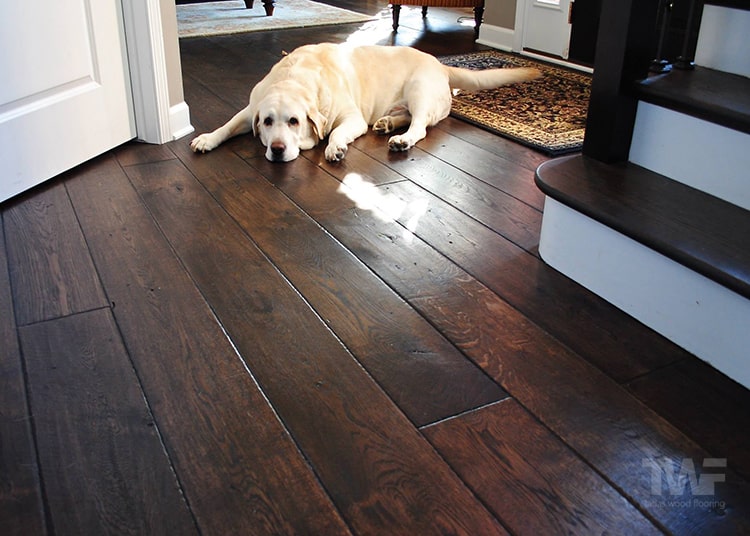
They were stained a mix of Ebony + Sedona Red to give it a beautiful dark rich look…
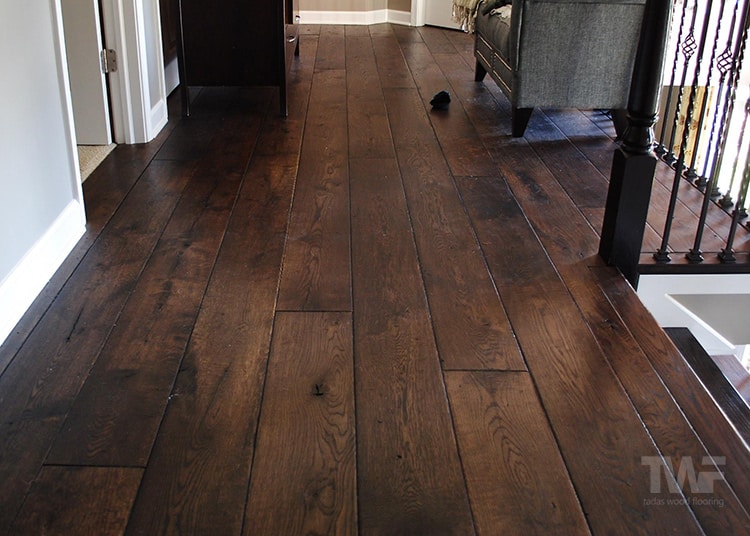
You can see more projects we’ve done with Magic Oil on our Photos page.
Again, like we’ve discussed in detail before, we realize that these finishes aren’t for everyone. If you love the super shiny gloss look, or a surface finish with a lot of build, then you most likely won’t like Magic Oil. But… if you love to look of a hand-rubbed oil finish and a nice velvety matte sheen, then it really doesn’t get much better than this.
It also definitely needs to be maintained and re-coated every so often which might be off-putting for a few people that want very low maintenance. But for those that see the benefits that it offers long-term, it could be the perfect finish.
We also love that it is durable enough and has super low VOC’s so it can be used in commercial environments.
Next we’ll have a look at all of these hardwax oils side-by-side and see how they stack up next to each other. Then we’ll choose our favorite.
Feel free to ask any questions in the comment section below…
**2015 UPDATE** It’s been a while now since we put this finish down in the café. We went back to check up on it in Jan 2015 and were very impressed by how it’s holding up to the stores constant traffic. We can now wholeheartedly recommend Magic Oil for these types of projects.
**2023 UPDATE** We’ve written another full blog post about this hardwax oil. See what we think of Magic Oil 11 years on.
–
Updated Jan 2023


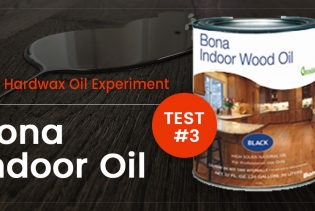
How difficult is it to mix the product together in small amounts. If you are touching up just a small area? It’s two part right ?
I am contractor in Indiana and am looking for something new to use can’t decide between the three Rubio OSMO and Pallmann. Ha sounds like a group from the seventies. Where do you get your pallmann products from.
Thanks,
Jason
Hi Jason,
Magic Oil is very easy to mix, just measure it out properly and you’re good to go. Our supplier for Pallmann is Chicago Hardwood.
All 3 are good products but we like Magic Oil and Monocoat the best. They both offer something different depending on what you’re looking for – more build or cool colors and zero VOC’s.
Hope business is going well over there.
Tadas
I am a homeowner considering a resand of my cherry floor and recoating with Magic Oil. I have tested the product in a closet and like it very much. I do wish it had a greater sheen, but I want the natural look of an oil finish as well as ability to spot repair. Can you suggest something to buff it with that would increase the sheen? Will Magic Oil Care do this? Since Magic Oil Care is hard to find in my area, any thought on using WOCA Maintenance Paste over Magic Oil? Thanks!
Tadas,
Thanks very much for the advice. I’ll check out OSMO. You guys have a great web site and are obviously a top line operation. I wish you were in my area!
Brennan
Hi Brennan,
If you want a hardwax oil finish but with more sheen I would suggest OSMO hardwax oil. If you use OSMO wax cleaner and buff with a white buffer pad the floor will have more sheen to it than Magic Oil can obtain.
I definitely wouldn’t recommend mixing different systems together.
Hope your floors turn out great for you!
Tadas
You are not kidding about how hard its is find info on this product. Is there a link you can post?
Hi Maria,
You can now get it direct from Amazon.com here: Pallman Magic Oil
Tadas
Greetings Tadas,
Congratulations on your site, it is very well done and informative. My question is — have you worked with WOCA? A Danish hard oil finish / no wax. We have a Brazilian Cherry floor that we will be having re-finished and in my quest for the best product I came across WOCA natural oil. Our floor was originally finished with Glitsa Swedish finish so it will have to be sanded down to bare wood for the oil to penetrate but other than that it reads like a great product. I would feel more confident if I had the kind of information you have provided with the oil wax finishes.
Thanks for your interest.
Don
Hi Don,
Thanks for the compliment. We haven’t worked with WOCA yet but we’ve definitely heard about it. One day we might get to test it out properly and write a review.
In the last few years there have been a number of hard wax oils emerging on the market due to the popularity of these finishes (although WOCA has been around for some time). Unfortunately we don’t have the weeks and months needed to test every single finish on the market thoroughly – there are 100s of them – and then spend days compiling and writing reviews for each one… that would be a full time job and we’re crazy busy restoring floors as it is :)
If you’re really interested in this particular finish Don I suggest getting a sample and do some testing yourself on a spare piece of wood or in a closet. If its a popular finish in you area you also might be able to get some real world experience from a local floor refinisher.
Let us know what you find out… and good luck with your refinishing project.
Tadas
Tadas,
Thanks for the surprisingly quick response. My response is delayed because I wanted to do some more fact finding. I found that WOCA has been around for 30 years but their Diamond Oil is a relatively new product that has no wax and is 95% solids. Living in SW WA anything new or different than what is historically used locally has to be found on the net. That being said at least our re-finisher is willing to give Woca Diamond a try (the other two were not). Their web site appears to gloss over and ignore the real life application details and options. For example they say avoid water on the floor for three days while it is curing — I read one contractor complaining because he had to return to a job for another application because a dog drooled on the floor before it was fully cured. What they did show was a picture of water beaded on a cured floor. Part of our floor is in the kitchen and if the curing is that sensitive we may have to move out during the cure time. Their video instruction shows it is a one coat complete job but elsewhere they say to buff in the second coat 6 to 12 hours after the first (logistically that seems difficult to time). They refer to their product as Pre-treatment Diamond Oil — pre-treatment to what they do not say. I’m not sure if it is a language communication problem or incomplete instructions / it might just be my own lack of floor finish knowledge.
It would have been nice to have a guy like you really use and test the product but as you suggested I will have to hope our contractor is so inclined.
Thanks – and I will pass along the end result,
Don
Hi Tadas,
I’ve really appreciated reading your “bake off” between these four products. We’re considering using Monocoat or Magic Oil on a kitchen floor but we’re DYI. My amateur’s question is how do you buff these products into corners? The husband wants to go with stain and poly so I need to come up with a response to this problem! Thanks.
Lorene
Hi Lorene,
Here’s the Rubio Monocoat application instructions with pictures: http://rubiomonocoatusa.com/resources/1/oil/app_instructions_trifold.pdf
That should help answer your questions to convince your husband :)
Good luck with the project.
Tadas
Hello, I came across your website when searching for Pallmann Magic Oil reviews. I was even more excited to see that you used the product on rustic reclaimed flooring (which look BEAUTIFUL), as that is what we are having installed in our home! Did you think the coverage estimates per liter were accurate for use with reclaimed floors (mostly read and white oak, little bit of maple)? Thank you
Hi Kate,
From what I recall the coverage was pretty accurate. It will take a little bit more product because there is a bit more surface area to be covered because of the dips, saw marks and checking etc. The floor will need to be sanded pretty smooth too… not to remove the character but to make it smooth enough to walk on and not get socks caught on it.
Good luck with your project Kate, I hope it goes well.
Tadas
Hi Tadas,
I really enjoyed your detailed product testing results. I’m considering either the magic oil or monocoat for my project. I have a home office/den that is about 150 sq feet and I’m waiting delivery of reclaimed antique Chestnut. I think I may like the magic oil because it has a little more sheen. Do you think either of these would be a good choice for a home office? I don’t want to put a plastic poly on top of a beautiful wood, but I want to make sure these would be good for a slightly softer wood.
Also wondering if you would recommend carpet or plastic under my office chair to protect it.
Thanks,
Jeff
Hi Jeff,
Either one would work great with your floor and look great too.
For your office chair it’s not the surface material that matters but what’s underneath it that comes in contact with the floor that’s the most important. You don’t want anything too hard or abrasive that will scratch and wear down the finish over time. Some of those plastic mats have hard plastic divets that easily damage surface finishes. Carpet backings can be very abrasive too. The best solution is to choose whatever top surface you like that will allow your chair to manoeuvre easily and then put a soft non-abrasive layer between that and the floor. Make sure to clean under it regularly though as it will be a great dust magnet :)
Hope that helps and good luck with your project Jeff.
Tadas
Hi Tadas,
I have a DIY project gone wrong. Yes, I know this is why should have hired a professional:/ We have heart pine flooring. I thought I had done my online research and we had decided to go with tung oil because we wanted to be able to spot repair. We have a family of 6 and our old water based finish really took a beating. Anyway, we sanded the floors down and applied the tung oil. The color was just horrible – very orangy. After spending a whole morning calling wood specialists and floor refinishers, we decided to sand it back down and start over. We stained the floor right away to protect the wood while we looked into what kind of finish to use. No contractors in our area (Ohio) seem to know about anything other than water and oil polyurethanes. I came across your site and discovered hardwax oil. It sounds exactly like what we’re looking for only I wish I would have found it sooner. Here’s where my nightmare project currently stands. I used gallon size Minwax to stain my floors and it has not fully dried. I talked to Minwax customer service who asked how much I used for the square feet I was covering and he though it sounded reasonable. He suggested I wait it out. It’s been 2 weeks and it hasn’t dried. I called back this week and they told me to wipe it down with mineral spirits to remove the excess. They said any glossy spots are excess. Well, we have a lot of glossy spots and I’ve wiped and wiped and feel like I could wipe forever before it would go away. We took sandpaper and gently rubbed it and that seemed to do the trick. Here’s my question: If we gently sand off the glossy part, can we use one of the colored hardwax oils to help make the color more consistent? We went with a darker stain (Dark Mahogany/Provincial mix) and don’t mind making it darker as long as it doesn’t get too blotchy. If we go this route, which product do you think would be the most forgiving? I see Magic Oil has a dark brown color, or Rubio Monocoat in the Chocolate or Mahagony. If you have any other suggestions, I’d love to hear them. This has become a month long project and has cost us more than expected so we don’t expect perfection at this point – just something we like. One thing we do not want to do is resand the floors all the way down again. That may just be the most depressing thought ever. We have about 700 sf by the way.
Thank you!
Dana
Hi Dana,
Sorry to hear about your flooring troubles :( Its horrible when things go wrong hey. Don’t beat yourself up too bad, it can happen to us professionals at times too.
This is a hard one to comment on without seeing the floor or site in question. Personally if i was called in to help I wouldn’t touch the floor without sanding it down to bare wood again so I knew all prior traces of finish (tung oil, waterbased etc.) were completely removed and the floor was up to professional standards and ready to coat with no contaminants. I would also check for any moisture issues. Stain should never take that long to dry. From my limited perspective behind my computer screen it seems you have either a contamination issue or a moisture/airflow problem. But that’s just an educated guess.
Technically, if everything as been prepped correctly, you should have no problem using a hardwax oil over fully dried stain. You will need to do thorough testing in different areas to make sure it will work in your case though. Test, test and test some more Dana. You don’t want another finish system not working on your floor.
I hope this is of some help and you get them sorted out. Let us know how you go.
Tadas
Thanks so much for posting these reviews. I wish you were in my area, no one in our state is doing these low/no-voc finishes (or if they are, they are keeping a tight lid on it). I plan to order a few Rubio samples but am not sold on the super-matte appearance so am trying to find samples of Pallman’s Magic Oil and have emailed UFloor – our previous house had Dura Finish’s satin liquid wax and we loved it so are trying to find a less-toxic alternative. Have you used any of the colored Pallman’s Magic Oils? I’d like to avoid the high-VOC stain we’d originally chosen (Dark Walnut) and go for an all-over low VOC finish if possible. Thank you so much for the public service you are performing by testing this for all us in the “sticks”! :)
Hi Mia,
I’m glad you’ve enjoyed the reviews. Unfortunately we haven’t used the coloured versions of Pallmann Magic Oil yet. That’s something we really should do one day though. Our clients have always chosen to have us stain with their preferred color first and then we apply the clear oil.
Good luck with your search for someone in your state that will do it and with your project Mia.
Tadas
Thanks so much for the reply, Tadas! I found a way to order samples of both from a distributor (I hope) so will do that and report back for future reference as I’m sure there may be others scouring the internet for info like I am!
Sounds good Mia. Looking forward to your findings.
Tadas
Have you guys tested waterlox? We were looking for something that is durable and easy to spot refinish. I thought i read about wax floors being really high maintenance with having to reapply often. Is that not the case with Rubio Monocoat and Pallmans?
We have kids with lots of toy cars, what would you recommend? We like a more matte finish – nothing like plastic.
Thanks!
Hi Brenda,
Yes we’re familiar with Waterlox. We don’t use it though because it has very high VOCs, it stinks for days and days afterwards and there are better finish systems available – it does look good once down though.
I think you’re getting hardwax oils confused with traditional wax floors. These are very different finish systems. You can see some of what hardwood floor owners had to go through to maintain their waxed floors decades back in one of our recent blog posts here:
https://napervillehardwood.com/blog/wood-floors-in-the-1920s/
Hardwax oils don’t need anywhere near this type of constant maintenance.
You mentioned you want something “durable and easy to spot refinish” and “a more matte finish”… hardwax oils are all these things. Of course durability depends a lot on how the floors get treated. Kids with lots of toy cars being carelessly pushed, pulled and dragged across the floor and are going to ruin any type of finish if they constantly play very rough on them. The repair-ability of hardwax oils is very good but it’s not able to magically remove deep scratches and gouges below the finish surface.
I would definitely recommend looking into Pallmann Magic Oil or Rubio Monocoat for your situation. Our favorite is Magic Oil.
Good luck Brenda, I hope your floors turn out great.
Tadas
Love your site this has been great! Looking at having my contractor go with this system, you indicate that you can stain and use the neutral – what type of stain can be used?
Hi Doug,
We usually use Duraseal but any good quality stain should be ok. Just test for compatibility first.
Tadas
Hello! Your site is so helpful – thank you for being so generous with your time! I am wondering if it is possible to use the Rubio fuming product for coloring a new white oak floor and then sealing it with the Pallmann Magic Oil. Or maybe it is better to stick to the same brand and use the monocoat to seal.
Thanks!
Hi Amy,
Sorry for the delay, been a little busy. To answer you question – technically yes it should be able to be done. You would need to conduct proper testing for compatibility and adhesion of course. But personally I wouldn’t. The fumed would turn yellowish with the Magic Oil on top as it’s not completely clear. I don’t think it would look that good.
Also we don’t like to mix and match different systems. There is a lot of chemistry that goes into these systems and we don’t like to mess with them and tempt fate. It can get very expensive and time consuming when things go wrong.
Hopefully that was helpful even though it wasn’t the answer you were hoping for :)
Tadas
I am a homeowner who has had Magic Oil applied to existing red oak flooring, sanded down of course. I am so disappointed and am beginning to think that maybe something was missed in the application. I’ve got water spots everywhere and I cannot seem to remove them. Everytime I turn around there is another scratch or blemish. We have only had the product on a week and I think we are going to have it sanded down to the bare and start with something else. Any advice?
Hi Sarah,
I’m strongly guessing it wasn’t applied properly. When applied correctly you shouldn’t be experiencing any of these issues.
The most common issues with inexperienced or first time users is not buffing off the excess oil properly and not working within the limited window of time there is for applying it. If too much oil is left on the floor because of either one of these then you can end up with a compromised floor like you have.
Was this done by a “professional” floor company Sarah?
I hope you can get it sorted out soon. Good luck.
Tadas
Hello,
First of all Thank You for taking the time to produce this site for us. The most informative site anywhere! I am in the process of staining my red oak floors with Glitsa Gold Seal Stain Sable Black. This stain has no sealer may I use Magic oil without sealing or must I use a sealer first. If so, which sealer would you recomend. Look forward to your response.
Thank You
Hi Hector,
Thanks for the compliment :)
Yes you can use Magic Oil without sealing. Just do a compatibility test first to make sure it works. We’ve never personally used the combination you’re using so we always test first :)
Good luck Hector.
Tadas
You have the most informative site in the entire webverse when it comes to HWO’s!
This is a bit off-topic, since it’s not floors, but I have a virgin walnut slab that I am finishing for a dining room table. My experience tends towards wipe-on poly’s, but, I am very interested in HWO for this new project for a number of reasons.
My questions are:
– Will HWO work well to protect against water rings from glasses? Would Rubio vs. Pallman vs. some other have any advantages?
– In my test samples of Rubio vs Wipe-on Poly, I love the matte and in-the-wood finish characteristics of Rubio, but, the poly seems to have more “glow” from the burl and the golden sections. Do you find that HWO’s are not as vibrant as poly, especially on walnut?
– How essential do you think water popping is? I did not pop in my tests….
Thanks!
Thank you Jsm :)
To answer your questions…
From my personal experience I would say that OSMO or Magic Oil is better for water rings compared to Rubio Monocoat.
Yes hardwax oils don’t have the sheen of high gloss polyurethanes. You’ll get a better sheen with OSMO or Magic Oil compared to Rubio Monocoat. If it is on walnut you may need 3 or 4 coats. I never used wipe on poly so I can’t comment on that.
Water popping is for making the color look deeper and darker. It is not necessary for the application otherwise.
Hope that helps :)
Tadas
Hi Tadas,
Awesome site; appreciate all the info. We recently had new Red Oak floor installed and finished with Pallmanns Magic Oil. The floor guy did not have experience with product, but was willing to try it. We ran into a couple problems, and would greatly appreciate your opinion.
First, we’d originally wanted the wood stained w/ Minwax dark walnut, before the Magic Oil was applied, but our floor guy said he talked to the Pallmans rep., and they recommended against anything but the Magic Oil color products. We were on a tight schedule, and so decided just to go w/ the natural finish. What stains have you had success with?
Outside the color, it appears the finish is compromised in places, especially in the kitchen where we are seeing lots of spotting and ‘dry’ patches. The installer admitted the finish set up on him faster than he expected leaving excess oil on the floor. The installer was willing to come back and rescreen and spot re-finish. But that raised the question of how hard it will be for us to spot-fix ourselves in the future.
If the floor was improperly finished in the first place, do we have to resand to bare wood, or just screen? Does a scratch or worn spot require resanding, and then reapplication of the oil? Is it possible to do small areas with just a hand sander, or buffer? Apologies for all the questions. Love the look of Pallmans for the most part, but worried now about how much work & expense I’m settng myself up for down the road… I’m wondering if we should just sand everything down to wood, and start over with Pallmans 96 or 98, and live with the plasic look.
Thanks for your help!
Bill
Hi Bill,
Sorry to hear of your flooring troubles. Yes hardwax oils can be tricky for people without experience – even professionals.
What he needs to do is maroon pad the floor and apply another coat. Don’t use a screen. Wait for it to penetrate for about 25 mins and then buff it off really well. We use a carpet pad for this step. Then go over it again with a white pad for a final buff to even out the finish.
Tell him to work in smaller areas – 150sqft or so – if he is just learning. And don’t mix the whole can at the start, mix smaller parts as he goes along otherwise it will set quicker on him like it did last time.
I hope he can get it sorted out for you Bill.
Good luck.
Tadas
Hi,
Fantastic site, very helpful!
One question. We have dogs…. and are thinking of putting down hickory flooring in our living room. How would the Pallman magic oil stand up to dog urine (if caught soon after the act)?
Thank you,
Tricia
Hi Tricia,
To be honest I can’t remember our testing results with urine. Let me try test it out in the next week or so and I’ll get back to you. If you get it cleaned up quickly it should be ok… but its the ones you can’t get to straight away I would be worried about.
Tadas
Wonderful, informative site! I’m considering what to refinish my 100 year old pine stairs. We’ve stripped and sanded them down, and I want to use a quality product that will not be too difficult to apply and it needs to be really durable since stairs are a BEAR to strip and sand down. It has to be right the first time! The hardwax oils sound great, but do you do the buffing by hand? Or would the Pall-x 98 be best?
I know you’re busy, so if you could even link me to some answers that would be so very helpful!
Hi Rebecca,
Yes stairs are a fun project :)
To be honest I don’t have too much experience with pine and hard wax oils. In saying that I think it would be a good choice to use OSMO or Magic Oil. I would in my own house for sure.
Application by hand is not that difficult. It is very easy to control the finish compared to professional two component finishes like Pall-X 98. Apply it to 2-3 steps at a time and let the finish sit for a few minutes and then wipe the excess off really well with a rag. Since it is pine may take 3 or 4 coats.
Let us know how you go. Good luck.
Tadas
Hi, excellent site! I’m planning on using a hardwax oil formulation for my white oak kitchen floors. I’ve narrowed it down to 3 contenders: Pallmann Magic Oil, OSMO and Fiddes. It strikes me that OSMO and Fiddes are essentially the same beast (chemically, application method, sheen/build, etc.) with Pallmann being quite different. I think I have a good handle on the specs for OSMO/Fiddes, but I was hoping to get your “real world” insight on a few Magic Oil questions:
1. Roughly, what kind of coverage do you tend to get for Magic Oil (again, white oak is my subject for this)? The label has a significant range; 350-600 square feet per liter can, I think. My kitchen is ~215 square feet. Summary question: From your experience, do you think I’m stretching a 2-coat application if I only order 1 can?
2. I’m a little confused about spot repairs for Magic Oil. For a small scrape or stain you might sand out, would you simply apply the oil alone WITHOUT hardener, or do you need to do a fresh 10:1 mix each time? Or, alternatively, does one of their care products accomplish this?
3. I’ve seen one head-to-head stain resistance test between OSMO and Fiddes (and a few other UK/EU brands) involving typical kitchen spills. Fiddes seemed to edge out the others in terms of durability. Any feedback from your Magic Oil kitchen floor customers regarding typical “kitchen abuse” durability (water, detergent, grease, acidic sauces and juices, diabolical toddlers, etc.)?
4. Finally, I’m looking for a bit of data I haven’t been able to extract from any other hardwax oil resource. Do you know how deep these finishes tend to penetrate? If so, do different “families” of these finishes (let’s say OSMO vs. Rubio vs. Magic Oil) tend to penetrate to different depths? I ask because I’m curious about future flexibility. For example, what if it turns out, for any number of reasons, you’d like to switch over to a traditional poly application, or maybe just switch to another hardwax oil product? Obviously you’d need to remove any trace of the existing hardwax oil for the poly; maybe less crucial for a different hardwax oil. Do you suspect that you would need to remove a markedly greater amount of wood during sanding? An extra 1/32 might not matter much, but if the oil sinks down something like 3/32 one might be in big trouble.
So, simple summary question: Are you pretty much committing to a hardwax oil for the life of the floor?
Thanks very much for your time. Again, this site has been extremely helpful!
That’s great to hear Eric. Thanks for popping back with an update :)
Tadas
Tadas: Many thanks for the helpful response! It’s been a little over a month since I put down the Magic Oil and I couldn’t be happier. It continues to repel water and other kitchen spills, and is holding up to assaults from two toddlers (toy truck wheels, marbles, finger paints, etc.). Zero scratches so far (felt pads on the kitchen table and chair legs are a must, I think).
Again, this website was extremely helpful throughout this process. I wish I could show my gratitude with a big pile of refinishing referrals, but I doubt you’d want to commute to New England :)
All the best, and keep up the great work!
– Eric
Hi Eric,
My apologies, I overlooked your comment. It’s been a busy summer here. To answer your questions…
1. The square footage depends on what grit of paper you finish with and the type of wood. Also whether is it stained or water popped. Usually we are getting about 450sqf for the first coat and about 900sqft for the 2nd coat.
2. It needs to be mixed with the hardener for touch ups. Magic oil care is more to maintain the fresh look, but it will not substitute for the actual finish.
3. We haven’t had any complaints. Even the restaurant in the article above doesn’t need re-oiling after 2 years which is pretty amazing.
4. The sample boards I re-sanded for testing purposes did not show too deep of a penetration. It was not any different than sanding off a regular polyurethane finish. I would say there will definitely be no problem re-sanding the floor in the future if you wanted to use another finish.
Hope that helps.
Tadas
Hi, just a follow up in case anyone is interested. I ultimately went with Pallmann Magic Oil and I could not be more pleased! The application went very smoothly (once I got a sense for how it troweled on and how the buffer pads absorbed the oil) and the dry/cure times seemed to match what they advertise. The finish is just amazing, visually and in terms of feel.
So, to address my original questions above:
1. 1 liter of oil + hardener ALMOST covered my ~215 sq ft of white oak with 2 coats, but I probably put it on a little thicker than needed at the beginning and thus wasted some. I spoke with a rep at Pallmann/UFloor who suggested ordering a few of their .75ml tester “pucks” just in case. A single puck in addition to the large can was all the extra I needed.
2. The rep at Pallmann suggested using the hardener for spot repairs in high traffic areas, but also said that for out of the way areas just the oil itself would likely suffice (but take longer to dry/cure).
3. Not sure yet; time will tell. But it seems to hold up at least as well as my Osmo and Fiddes test pieces thus far.
4. I haven’t tried sanding down anything coated with Magic Oil yet, but I originally tested OSMO and Fiddes on freshly-sanded flooring in the back of my refrigerator and dishwasher “nooks,” then sanded down those areas again before the Magic Oil application. I got down to bare wood pretty fast, and the Magic Oil later penetrated those areas quite well. So, I sense the penetration isn’t so deep that it will commit you to that once product forever.
And as an aside, I liked the Fiddes much better than OSMO in my tests, both in application and finish. I’ll probably keep that can around for other projects.
But again, I’m totally blown away by the Magic Oil! Absolutely the right choice in this case.
Thanks and all the best!
Hi Tadas,
I’m a home owner in California restoring my 80 year old red oak floors. How Much Pallmanns magic oil 2k would I need to purchase for 1000 sqft application on red oak floors? Would I need to apply 1 or 2 coats? Any Experience or opinion on how the Neutral (no color) finish looks on red oak? Great web site! Very informative. Thanks for your time and any input on my questions.
Hi Joe,
We are getting about 450sqft per liter for the first coat and about 900sqft per liter for the 2nd coat. So for 1,000sqft we would use about 3 liters give or take depending on the type of wood, if it was stained and waterpopped etc.
If this is your first time doing it yourself you should buy extra as it isn’t as easy to get that kind of coverage without the right tools and some practice.
Yes you need 2 coats.
We haven’t used the Neutral (no color) finish on red oak itself as we usually stain the floors first. I’ve seen it on a sample board though and it looked ok I guess. Best to make a sample for yourself first though.
Good luck.
Tadas
Hello, what a awsome site, thax!
Got a unusual application, antique heart pine on a covered porch. Sun will be hitting it in the afternoon, and about 5-6 times a year it will get wet from hard wind blown rain. In Louisiana, so it doesn’t get cold, but stays hot and humid.
Wood is sappy, 3″ t & g.
Don’t won’t a shiny surface just mainly want protection from the elements, and very low maintenance. What do you recommend?
Thax again.
Rob
Hi Robert,
I’m not an expert on exterior finishes unfortunately but if I where to do a deck for myself I would be very interested in using this:
http://www.monocoat.us/Exterior-Wood-Oil/
Looks like it might work for your situation. Worth having a look at anyway.
Tadas
Hey man,
Thanks so much for the response/recommendation. I will investigate. Is this a product you sell?
Robert
Hi Robert,
Sorry I missed your comment. No we don’t sell the finish on its own but rather as part of a complete sanding and refinishing package.
Tadas
I echo what many others have posted… great website. I have found the information here very helpful as I’ve conducted several tests on a number of Rubio Monocoat colors and combinations of colors. Unfortunately, I haven’t found the exact right combination. The Pure is too amber and none of the colors are “clear” enough. I tried mixing 2 to 1 Pure and 5 %White, which was OK, but still a little “cloudy.” So, here’s my question. Will either Magic Oil or Osmo give me the look I’m trying for? Thanks in advance for any input!
Thank you Shelly,
To answer your question… most likely not. Both products are oil based and will be amberish (if that’s even a word). It sounds like you’re after the look of a water-based product which will be very hard to emulate with an oil based finish.
Tadas
I have read all your reviews… really nice and informative. I’m really interested in these finished for furniture. Can you comment on that at all? I figure if they are durable enough for a floor, they should work for furniture, right? Currently I use Waterlox and oil/varnish mixtures, but these finishes sound perfect for what I like to achieve. Can you tell me if the application would be different, or if they are even suitable for furniture? Thanks!
Hi Matthew,
Yes I would definitely give them a go on furniture. I know of others that have and they’re pleased with the results.
Tadas
Thank you so much for your posts! Very valuable information. I’ve been researching Magic Oil and wanted to know what the procedure is for small touchups. Can it be done by the homeowner and does it require any special tools? Thanks again!
Hi Tadas, just wondering if you could respond to my previous post. I’m really interested in this finish but just want to know how easy it is to touch up. We have kids and pets and I don’t want to keep calling the flooring guys to do repairs. Is it possible for homeowners to do touchups? Thanks!
Hi Ray,
I’m so sorry I overlooked both of your comments! Not sure how I missed them.
Anyways yes it is relatively easy to retouch small areas although there are quite a few steps in the process. The procedure is the same as sanding and applying it in the first place. Instead of me repeating it you can see the instructions in their pdf here:
http://www.pallmann.us/uploads/tx_dddownloadmatrix/Magic_Oil_2K_PDS.pdf
Hope that helps.
Tadas
Hi Tadas,
I just picked up some Magic Oil 2K from my local distibutor…very exicited to try it, but I have two questions for you:
1) They said I only needed to apply one coat if I stained the floors…is this true?
2) I purchased an extra bottle of the hardener. The data sheet says you can double the amount for high-traffic areas. I plan to do this, but my question is should I expect any difference in application (will it scrape/buff any different, any thing else, etc)
Thank you for the advice.
Hi Brandon,
We would still use 2 coats. The extra hardener won’t be too noticeable but it will be a bit tougher to sand down when you do any touch-ups down the road.
Tadas
Hi Tadas, Based on your excellent, detailed review we have started using magic oil on all of our flooring refinishes. So far we’ve used it very successfully on 100+ year old floors being refinished and new quartersawn oak floors being finished for the first time. The results are superb.
Our next project is reclaimed, dirtytop heart pine. The wood is in good shape (not terribly splintered etc) but is definitely as distressed as one would typically expect of dirty top flooring. I know you said you don’t generally recommend magic oil for softwoods. But the old heart pine is really so much more like a hardwood. Do you see any reason why we shouldn’t use the magic oil?
Thanks so much for being so generous with your advice!
Hi Cate,
We don’t have much experience with heart pine sorry so unfortunately I can’t be of too much help. I think it would look great though. The main concern I would have from your comment is the floor is “not terribly splintered” which means it is a bit. You will need to be VERY careful with the buffer so you don’t rip these splinters out and ruin the floor.
Hope it goes well for you.
Tadas
Hi Tidas. Like everyone else, I want to thank you for maintaining such a high quality website. I was recently introduced to Magic Oil and am considering applying the gray colored product to 4″ ash. Our small sample looks great! One item of concern is the comments made in your Magic Oil review and Pallmann’s web site: Pallmann Clean’ should be used every few years to remove any residue from the previous two cleaners before applying another coat of Magic Oil.
We are looking for a lower maintenance floor but like the matte finish, low VOC and the natural appearance of this product. How involved is the application of the Pallmann Clean product and is the application of a new quote comparable with the original application? How frequently would you recommend the re-application? We are “empty nesters” with no pets planned.
Secondly, is it your experience that re-application would be required for the entire floor, or just the high traffic areas. We plan on installing ~1600 sq. feet.
Lastly, does the Rubio Monocoat require the same type of re-application after several years, or might this present a lower maintenance alternative?
Thanks in advance for your time to respond to this message.
Herb
Sorry for the typo…
How involved is the application of the Pallmann Clean product and is the application of a new COAT comparable with the original application?
Hi Herb,
It sounds like the product that would be better suited to your situation is Magic Oil Care. That could be applied every 12-24 months or even 36 months if you keep the floor clean and have little traffic.
If the floors get worn after many years then you can use the Magic Oil Clean to remove the Care product and re-apply the finish. The Care could be applied without moving furniture if you want but the Clean and re-application would be best to do with everything removed. It is much easier than the original application because it will be sanding free.
Hope that helps.
Tadas
Excellent and helpful review! I am thinking that Pallmann Magic Oil is the product for our project. We are putting in a new wide plank (7″) pine floor and are looking for a fairly rustic look in our lake cabin in Minnesota. Material was locally logged and milled for us and looks really nice. Would like to do minimal sanding if any at all. Maybe just touch ups as needed prior to finishing. Do you think the trowel application method will work for this? Also would you think coverage would be to the low end of the 350 sqft/liter? We are going to finish 1100 sq ft. Will 6 liters be enough for 2 coats?
Any help you can provide is greatly appreciated!
Hi Ryan,
Thanks :)
The best application will depend on how ‘rustic’ the flooring is. If it is fairly smooth then you could use the trowel application. If it is more rustic than smooth then the buffer application would be best. We always use a buffer as you need it to buff off the product anyways. Yes 6 liters should be more than enough.
Hope it goes well Ryan.
Tadas
Hi Tadas,
Thank you for the informative blog. We had a new oak floor installed almost 3 years ago in our attic. It was finished with Magic Oil, which looks absolutely beautiful. I would like to keep it looking that way and was wondering about proper maintenance. So far I have only vacuumed the floor. I read on Pallmann’s web site that Magic Oil Care is supposed to be applied every 2-6 months depending on the use. Also, it says that application requires proper ventilation. Does it really need to be applied so often? Also, if it requires ventilation how safe is it to apply around kids? My son’s bedroom is going to be in the attic. Would he have to spend the night in another room while the product is drying?
Hi Elena,
Every 2 months is too much. If you’re vacuuming them regularly and keeping them clean then I would do it every 6 – 12 months. Remember this stuff is diluted 1:20 so it is mostly water. Yes you should have ventilation when you use it but if you did it in the morning and ventilated the room I would think you would be fine to sleep in it that evening. It dries quite quickly.
Hope that helps.
Tadas
This blog has been incredibly helpful. Thank you.
I have a three-part question. We sanded down a 200 square foot floor, wiped it down with odorless mineral spirits, and then applied one coat of minwax wood finish penetrating stain in special walnut. We sanded using increasingly finer sandpaper, and spent about 13 hours sanding with a rented machine from a big-box store. After the stain was put on, the color was blotchy, uneven, and there are “wave” patterns across the floor.
1) What is the best way to fix the blotchiness and waves? Will this require a re-sand?
2) Is it possible to apply Pallmann Special Oil after the minwax stain?
3) I would like to use a low or no-voc option (like Pallmann or Osmo), but I am having a horribly difficult time figuring out where to order either product. Do you know the easiest way to purchase samples or liters of these products? We like in the Kansas City area.
Thanks!
Hi Lynnora,
Sorry to hear about your troubles :(
To answer your questions…
1) Yes this will need a total re-sand. It is very hard to get a professional job using rented big box store machines. I would strongly suggest hiring a pro with a proper industrial belt sander to level out and clean up your floor. If you try to fix it yourself with the same rented machine it will just make the problem worse. Unfortunately it is going to remove a lot of life from your floors :(
2) Yes this is possible but always test on a small area first to make sure for your particular situation.
3) Not sure about suppliers in Kansas City sorry but if you give the company a call they should be able to put you in touch with a distributor. If not then you could order online and get it shipped.
Hope you can rescue your floors. Come back and let us know how it goes.
Tadas
Hi Tadas,
I’ve been researching for quite a while, and your website is, hands down, the best resource out there on hardwood floor finishes.
I am getting ready to refinish our existing wood floor in the kitchen/entry, and have wood installed in the dining room and living room as well. The existing wood (white oak, common #1) has a water-based poly finish, which was done when we built our house about 10 years ago, and with two kids and two dogs it’s taken a beating. I am planning on refinishing with a hardwax oil – probably the Pallman Magic Oil – because I love the low VOCs and the beautiful, natural look. But, here’s my concern…
We have an 80-pound white German Shepherd that obviously has contributed to a lot of surface scratching on the existing floors (any of the deeper scratches have been caused by us humans). I’d like to get your thoughts on how the Pallman Magic Oil would hold up to a big dog’s fingernails over time, specifically…
1) How would it compare to our poly finish (which looked pretty marked up and probably needed refinished about two years after we got the dog), in terms of how visible the scratches would be after a few years? I know the poly coating can be more reflective of light and make scratches more visible, but I’m wondering if you have any specific knowledge of this vis a vis the hardwax oils you’ve used.
2) An extension of Q#1 – Given that the dog’s scratches are mostly surface, do you think the normal, recommended maintenance schedule of the oil would be enough to keep the floors looking good – or might I be setting myself up for frequent sanding and reapplication if I go with a hardwax oil? I absolutely don’t mind the maintenance that goes with reapplying the oil, but just a hair nervous that in 2 years the floors could look way worse than 2 years post-poly.
From what I understand, the repeated oiling of the wood over time actually makes the wood stronger, so I’m thinking this would be the best choice in the long run. But I would love your expert input if/when you get the chance.
Thank you so much. You guys are the epitome of a customer-centric business, and I hope you are killing it in Chicago.
Amy in KC
(If only we had the Royals AND Tadas)
Hi Amy,
Sorry for my delay. And thank you for the compliment, we do try hard to be of help :)
To answer your question, if I had a dog, this is the finish I would use on my floors. I just saw a job we did a few years ago with Pallman Magic Oil and they have a number of dogs inside. The floors still looked great. I was very pleasantly surprised. I might do a blog post on it down the road to show everyone. It shows scratches way less than a poly finish and are way easier to keep looking good long term.
Hope that helped with your decision.
Tadas
Hi Tadas,
Thanks so much for all the great information, and taking the time to respond to all of our questions. I just finished building a large edge-grain countertop out of black walnut (about 3′ W x 14′ L). I had several professionals recommend rubio monocoat or magic oil, and I went with magic oil to get a little extra sheen. Sanded to 120 grit, then applied two coats consecutively (spread on pretty thin with plastic trowel-like tool, left on for about 15 minutes, excess wiped off with paper towels, then buffed with a random-orbit polisher with microfiber cloth covering. Immediately repeated same steps with 2nd coat. After curing, it looks very blotchy – lots of uneven sheen, almost hazy/dry in some spots, where it looks like the wood soaked up the oil more than the areas around it. My hunch is that since it’s edge-grain / butcher-block style, it’s maybe trickier since there’s such a variety of grain patterns, openness, etc. Maybe I didn’t sand well enough, or need to go to a higher grit? Or do I just need to apply another good coat (or two?) to even things out? Really appreciate any feedback! Willing to sand down and start over if that’s what it takes. The specific steps I used and materials were recommended by Pallman rep, by the way. But I’m totally open to changing any of that, whether it’s what I use to apply, buff off . . . whatever. I do have white and red floor pads, but not sure if those are of any use unless you’re using on a floor with the the machine they’re made to pair with . . .
Thanks again!
Rob
Hi Rob,
The 120 grit is good but you should only apply one coat at a time. Buff on with a red pad then buff off with the white pad. You can cut them up and use by hand if need be. Then instead of immediately doing a second coat you should wait till the next day. Apply second coat the same as the first. It sounds like you will need 3 coats. After buffing the last coat, wait 20 minutes and buff really well with the white pad again (a new one) to remove all excess residue.
As you already have 2 coats on I would buff off the excess really well and apply a third coat and see how that goes. Always make sure any excess is buffed off though as it will not be easy to maintain otherwise.
Hope that helps and good luck.
Tadas
Hi Tadas-
Like many others I want to thank you for answering so many questions. Your blog has been a great help.
My husband and I are experience DIYers and had to take on our doing our floors simply due to financial restraints. To make the whole thing more tricky we had some very old white oak floors as well as a new white oak floor in our kitchen. After going through the process which included staining the floors prior (to match the rest of the house) to applying the Pallmann’s Magic Oil, I would agree with you wholeheartedly that this is job that should be done by professionals, if at all possible.
I will say we did manage to get A GREAT RESULT. But it’s a lot harder than you may think (and we have done many types of home repairs/construction.)
Unfortunately, we had some paint leak through one of our painting tarps and it dried in spots on our hard earned beautiful floor !!!! I tried several methods to remove the paint from the surface, but finally resigned to sand and repair the spots. My repair job did not work so well. I sanded the spots feathering them out a bit, restained, waited 24 hours and then reapplied the Magic Oil buffing in well. The spots that were repaired now look like scuff marks instead of blending in with the rest of the floor. Is this a sanding issue?
Can you provide any thoughts to what I may have done wrong or how to proceed?
I haven’t been able to find anything on the Pallmann’s sites about how to repair it. Hoping for a better result the next go around
Also, I noted that you had told Rob he could add an additional coat of Magic Oil to his project after the first one dries. Can you do this on floors as well? The rep we spoke had suggested we only use one coat of magic oil because we we staing the floors prior to the Magic Oil. Basically stating that the floors would only absorb so much product. We are concern our floors won’t have the same durability without the second coat of Magic Oil.
Thanks so much for your time. I really appreciate it.
Jennifer
As a side note, anyone working with this stuff should wear gloves and arm/knee protection. I got a serious rash from exposure on skin.
Hi Jennifer,
Sorry to hear about that. It’s so frustrating when you put so much effort into something and it gets ruined like that :(
As you’ve discovered, stained floors can really complicate the repair process compared to repairing a non-stained floor with hardwax oil.
With the repair you need to follow the exact procedure you did with the original sand. Same grit sequence and even the same sandpaper. If the floor was water popped then that needs to be done as well. Then the exact same stain (hopefully from the same container) should be applied and wiped off in the same timeframe. It is not an easy fix if you miss one of the sequences. You may find its a better repair if you re-sand and stain the whole board. That way if there has been any UV damage, the whole board will at least be the same shade.
Yes it is possible to apply a second coat over stain. Just make sure each coat is buffed out well. That’s what will make the repair look better too, if you buff on another light coat over the surrounding area so the sheen matches. then it won’t look so much like the scuff marks you are describing.
I hope it works for you. Take you time and do it step-by-step.
Good luck!
Tadas
Ive noticed that a second coat of magic oil over a minwax stain doesnt look any better than 1 coat. Why would you need a 2nd coat?
Hi Brown,
The second coat adds more durability and build to the floor. It’s better to do two thinner coats as well compared to one thicker coat.
Tadas
I’ve had RM floors for almost four years now ( see previous post) and while I love the look they have been a maintenance nightmare. Easily stained by blueberries, or the like. Oily foods leave a mark, metal legs of furniture leave a black stain, and the new puppy teamed havoc while potty training. It was not a DiY and not sure if the product was ever applied correctly, though I’ve had the guys from RM out to look and they did not seem surprised. Need to reapply something, as parts of the floor near glass doors seem totally unprotected. Wondering if I can do magic oil over the Rubio? Would I need to sand it? Thanks for your site and your help.
Hi Lola,
Sorry for taking so long to reply. Sorry as well that your floors aren’t performing how they should. As we didn’t do them I can’t be certain if they were done properly or not. But most of the hardwax oils we see that have these issues, the finish wasn’t applied correctly. Mostly the culprit is that the contractor hasn’t removed all the excess oil and that leaves it vulnerable to marking and staining like you are experiencing.
As far as applying something over the top, yes that is possible. My suggestion would be a matte 2 component water based finish instead of Magic Oil. Magic Oil will darken and amber your Rubio floors whereas a water based finish won’t. It will dry clear. The effect of the ambering will depend on the color of Rubio you have too. If it’s a light color it will be more noticeable. You will need to clean the floors extremely well before doing anything. Best left to an expert who has done it before.
Sorry again you are having this trouble. I wish people would experiment on sample floors – or their own – before practising on paying clients :(
Hope you can find a solution you are happy with Lola.
Tadas
Hi Tadas,
Your website is really informative and helpful. We’re in Denver and are planning on white oak select floors in our great room (kitchen and family room). We have 2 young, active kids. Our contractor proposed a sealer, a coat of Pall X-96 followed by a coat of Pall X-98. Talking with the regional Pallman rep out here, he actually suggested that as well. But I’m afraid of the floor looking too much like plastic and I like how Magic Oil seems to be easier to touch up without too much hassle. We want to keep a light, natural color for our floors. What would you recommend: Magic Oil or the X-96/X-98 combo?
Hi Chuck,
Those are both top quality finishes and would be perfect for a young active family. Like I just wrote in the comment above, Magic Oil will amber the floors while waterbased finish is a clear finish. If you want to keep the light natural color magic Oil might not work for you. To be sure, ask for a sample of both finish systems and have a look for yourself. Better to know for sure instead of trying to guess. Any reputable floor company will be happy to do that for you.
Good luck with the project.
Tadas
Hi Tadas,
Great website with so much helpful information! I have very old wood floors in my house (1800’s) and just installed wide plank red oak in an addition. When we renovated the 2nd floor of the house (3 years ago), we installed wide plank pine and white oak and decided on a paste wax finish as we were told it was the most traditional option (trying to be true to age of the house!) and we don’t love the look of poly (or at least the poly we’ve seen). The only issue is the water spots . . . Now a flooring guy is recommending Rubio Monocoat, which I was ready to use after reading your website, but I’m nervous about the “unfinished” appearance that some people have commented on. Also, thinking it would be best to have all the wood floors in the house finished with the same product for ease of maintenance. So for my actual question . . . What do you think of paste wax? Do you think Rubio Monocoat would be the right look for our old colonial? Thank you!
Hi Brooke,
Your house and floors sound amazing. Yes, Rubio can have that unfinished” look for some people. It’s definitely very matte. Wax is a very labor intensive finish to maintain and as you found out, spots with water easily.
For your situation, I would probably suggest Pallmann Magic Oil. Same type of ease of maintenance as Rubio but with a bit more build and sheen which you seem to prefer. We love this finish system and have had absolutely zero issues with it over the years we have used it.
Good luck!
Tadas
Hi Tadas,
Your website is an invaluable source of info on HWO, thank you!!
What do you think about using the RMC fumed on new white oak select flooring and then Magic Oil on top?
Thank you!
Here’s one I forgot about with fumed and Magic Oil but on red oak…
Red Oak Fumed Magic Oil
Hi Dallas,
Yes that is possible and would look great. You can see a similar floor we did in the third photo down (Dan Wangler Builders) on this post here:
https://napervillehardwood.com/blog/custom-colored-floors/
The only difference is we also stained the floor after fuming it, then applied the Magic Oil.
Tadas
I have Magic Oil on my white oak floors all over the house and generally I love the look and durability. My one complaint is that it is not as durable in a kitchen as I had hoped. The biggest problem is that if you spill grease on it (which sometimes happens when moving a pan from stovetop to sink or taking something out of the oven) the grease soaks in immediately and shows, no matter how quickly you wipe it up. I am having to redo my kitchen for the second time in six years. Is there a solution (aside from banishing oil from my kitchen)? Maybe a doubling of the hardener?
Hi Jenny,
Sorry to hear about your troubles. Unfortunately I can’t be of much assistance as we have never had this issue.
Sounds like maybe too little finish was applied. We have applied it to numerous kitchens before and have had no complaints so far in 5+ years.
Was the floor water popped before application of stain or magic oil? Water popping makes a huge difference in durability, we water pop every floor. Maybe an additional coat is required depending on the floor type. For example pine may need 3 or 4 coats of Magic Oil. Doubling the amount of hardener could help, but I never have done it.
Tadas
Any tips on getting rid of Magic oil droplets? We 2 coats and floor turned out great but it seems like droplets are appearing now that 4 days have gone by?
Hi Dylan,
These occur from the final buffing with a pad. The pads get saturated and starts spitting drops. You can’t see them right away, but when finish dries and cures the floor settles into its satin sheen and the drops remain shiny.
I usually run a clean cotton rag under the buffer for the final run to pic up the invisible drops. If you miss any, the drops are the easiest to remove with plastic spatula next day. If you leave them a few days probably only a razor blade could remove them, but most likely you will need to touch up the finish.
Hope that helps.
Tadas
Can elaborate any more on the working time when applying the magic oil? Specifically with white oak floors:
-Once I start applying with the trowel, what is the minimum and maximum amount of time before I need to start buffing? The instructions from Pallmann vary on this. If not a hard number of minutes, is there anything to watch for in the oil’s curing process to indicate “I’d better get back to that with the buffer now”?
-Once I start buffing and get the first pass done with the red pad, is a bulk of the rush over now that oil is mostly off the floor?
-What is the amount time you’d recommend spending on each step, applying oi, red buff, white buff, cloth buff?
Basically I have ~260 sq ft of floors with a large amount of interior corners to be finished and I am trying to figure out if I should do each coat in 1 big section or two sections. Right now I plan on starting a timer when I start and have that dictate how much I’ll tackle at once but I need to know how long to set the timer for to make sure it comes out nicely.
Thanks for this website and blog, it really is exceptional.
Alex
Hi Alex,
These instructions here are pretty much what we follow:
http://www.pallmann.us/uploads/tx_dddownloadmatrix/ Magic_Oil_2K_PDS_English.pdf
Just get the initial excess off with the red pad and then polish with the white pad and cloths. You need to keep buffing until there is no oil left on the floor. You should be able to do it in one section. We don’t set timers when we do it so I can’t give you any definites sorry.
Hope it goes well for you Alex. It’s a beautiful finish.
Tadas
Tapas,
We have dogs and when we built our new home we installed White Oak solid hardwood floors. We applied the Magic oil 2K product and it wears beautifully. Our problem come with the dogs, if they have an accident on the floor we have terrible staining.
How can we repair this small spots in the floors?
Hi Terry,
Dogs, the bane of every hardwood floor guy :D
To repair these areas you can sand the spot and re-apply the Magic Oil. Make sure you use the same sequence of sandpaper and grit so it matches the surrounding floor. If it was water-popped you’ll need to do that too. Then apply the same amount of coats as the rest of the floor. If you take your time and do it properly it should blend in nicely.
Hope you can get them sorted Terry.
Tadas
Quick question, do you typically water pop your flooring before using magic oil?
Hi Matt,
Yes we do.
Tadas
Tapas,
Great Blog.
I’m planning to install wide plank reclaimed white oak skip planed floor in a house I’m building. Will a hardwax oil such as Pallman or Monocoat work on the the partially planed boards of the hit or miss or do I need to go with something film forming (Bona Traffic) to help smooth out the un-planed areas. My preference would be the hardwood oils so I dont have to re-sand in the future, since re-sanding will eventually remove the hit or miss look. I also have dogs so I’m worried about their accidents staining the Pallman or Monocoat. I appreciate any advice you can provide.
Hi Dave,
Not quite sure what you mean by this “on the the partially planed boards of the hit or miss”. I’m guessing you’re wondering if the hardwax oil will go into the unplanned sections???
It will, but you may need to do those parts by hand, depending on how rustic they are. It’s impossible to say without seeing the floor in person.
As far as the dogs, I would suggest Pallman first.
Tadas
Refurbished my white oak floors and finished them with 1 coat of NEUTRAL 2K. Obviously a second coat is in the near future:
Has anyone ever topped a neutral colored finish with 2K White?..
Any thoughts are welcome.. idea if you didn’t catch this, is to make the floors more light/white.
Cheers
We haven’t with the products you mention. But we have done a similar process with other hardwax oil products. Experiment on some test panels and you should be able to come up with a process and color combo you like.
Tadas
I’m installing a cypress t&g ceiling in a bathroom (will be tiled over the tub), but wood will definitely see spikes in humidity/moisture during showers. I hate to completely cover the clear natural wood with a common poly coat, but is Pallmann Magic Oil or Osmo Wood Wax a good option for a BR ceiling that will be tough to (remember) recoating every couple years? What type of finish would you recommend in this application?
Hi Tim,
We don’t have any experience with this type of application sorry. As far as re-coating, a hardwax oil that is rubbed in would definitely be easier than a poly product. Sorry I can’t be of more help.
Tadas
Tadas,
We do complete luxury home woodwork interiors in China using American hardwoods – Walnut, Cherry, Oak doing parquet flooring, wainscoting, coffered ceilings, doors, cabinetry and custom furniture {haha we contribute to the American side of the trade deficit!!}. All told, from our time in California to the last decade in China we have used natural oil finishes for everything for at least 25 years.
We have developed a broad pallet of very clear toned, non-muddy, non-blotchy colors by doing a coat of oil, letting it dry, then applying solvent based dye, then topping off with one or two coats of oil. There are a few dark colors (especially on oak) where we direct dye the raw wood first then coat with oils. All the oil coats are put on wet and then buffed dry to the touch with rags before drying.
In China we’ve used Becker Acroma, {Now Sherwin-Becker} a product called GX-1540 which is a UV light curing oil-wax. We use a super high-intensity UV tunnel to cure the oil in a minute. We then final coat with a polymerized tung oil.
I would like to develop some finishes that do not require the UV tunnel, and I’m always experimenting and learning to do things better.
Which of the 3 hard-wax oils you tested and liked (Osmo, Monocoat and Pallmann’s magic oil) can we do apply more than one coat? Your review on Monocoat seemed to apply you SHOULDN’T do a second coat, but your review of Magic oil sounded like you do do second coats as you were talking about how you could do another coat after an hour but you like to wait overnight…
Also would like your thoughts on any of these finishes to wipe on for doors, cabinetry and furniture. On our oils above, we typically apply heavy on the first coat to get good saturation and penetration, but wipe everything off “dry” to the touch, then let dry/cure. With these oils, do you leave them “wet”? if so, how would one use them on things that are NOT flat like moldings, raised panel doors, etc.
Thanks for your wonderful blog!
Scott
Hi Scott,
Monocoat is a single application. OSMO and Pallmann Magic Oil are more than one coat. They shouldn’t be applied “heavy” and left wet though. That’s where you will run into issues of splotchiness and sheen issues. Apply them as per directions and buff them off very thoroughly. Buff twice as much as you think you should. And change the pad or cloth regularly.
It will be a bit more work on non-flat doors etc. as you won’t be able to use a mechanical buffer, but if you take your time by hand, you can get good results.
Good luck with the testing Scott. Hope it works out well.
Tadas
Hi,
I am installing new pine floors in my house. The wood will be kiln cured and then left to rest for a month prior to installation. I am stuck between using Rubio or Pallman. I have read good and bad things about both.
Which do you recommend? I have two medium sized (40 pound) dogs that live mostly inside so durability is a huge factor for me. I also live in Louisiana so rain, heat, and humidity are all factors. I also have some oddly shaped corners and areas that a buffer will not be able to access. Is it possible to apply either by hand in some areas?
What is the product coverage for either Pallman or Rubio on pine? How many coats would you recommend for pine? If I am doing 1100 square feet of smooth pine, how many liters would I need to apply sufficient coats?
Thanks,
Caroline
Hi Caroline,
Pine floors will dent and scratch with dogs much easier than other types of wood as they are very soft. The finish won’t stop that. But it will stop the damage from going through to the bare wood. We have a medium sized puppy at home and have Pallmann Magic Oil on our white oak floors and they are holding up exceptionally well.
Yes you can hand buff small areas that can’t be reached with the buffer.
Product coverage for Magic oil will depend on a few factors but for the first coat I would think somewhere around 200sqft/lt would be pretty accurate for the first coat on pine. You’ll get much more coverage with the second coat. I would do 2 coats and see how it looks, then do a third if need be. Of you can wait a year and do the third coat as a maintenance coat. Rubio Monocoat will most likely need a second coat on pine as well as they will be very thirsty. We don’t have pine floors up here so I’m not too experienced with it sorry.
Hope it goes well!
Tadas
Tadas,
I noticed above on Caroline’s question you suggested putting two coats of Monocoat on a pine floor. I thought Monocoat could NOT be top coated… Is it just that it is so good you only need to do one coat? What would happen on a hardwood floor if you did a 2nd or 3rd coat of monocoat? peel? Can you get more gloss with a 2nd coat?
Also, all these hard-wax-oil finishes are relatively matte, which one can I get the most gloss from? we generally like a satiny finish on our doors and cabinetry. We still want to stay with these oil finishes. Also, any advantages to doing a base coat with one brand and top with another?
Thanks for the reply above to my question. Yes we already do buff everything off by hand on the oil finishes we use. We buy t-shirt cloth rags by the bale!
Scott
Hi Scott,
Yes it could possibly work for pine floors because they are so porous and thirsty. Hardwood floors have a much tighter grain and will (in most cases) only sustain a single coat. Any excess not buffed in sits on top and is why a lot of DIY Rubio Monocoat floors look bad and don’t wear well.
The hardwax oil with the most sheen is Pallmann Magic Oil with three coats. It needs to be buffed in really well though.
We never put different brands of finish over each other. That will void both warranties for our clients and be a recipe for trouble.
Tadas
Thank you for the blog. Reading the product reviews and comments helped me decide to use neutral Pallmann Magic Oil on our newly installed red oak floor. They look beautiful, but there was a sanding mark that the installer has tried to fix twice now. Both times, the result has been that the re-sanded area is more matte than the rest of the floor, and there is a shinier band where the re-sanded area meets the surrounding floor. The installer said that he used the same procedure as the original finish, so I’m wondering if it should have been buffed more. I’m not sure what to do at this point, and I wonder if it needs another light coat across the whole area.
Thank you!
Mindy
Hi Mindy,
I would suggest the same… another light coat buffed in across the floor.
Hope it goes well for you.
Tadas
Tadas Sadunas,
My husband and I refinished our 106 year old Douglas Fir floors in our home in Portland, Oregon. I researched forever to find a product that would protect the floors but not make them look and feel like plastic.
I found the online series on Hard Wax Oil and your reviews on the performance of the top brands you felt you could recommend. I decided to use the Pallman’s Hard Wax Magic Oil with a dark tint. Wow! Our floors turned out beautiful! My husband trusted my research but when we were scraping on the product and then buffing it off, I think he began to question my product decision. That is until the floors fully cured and we could walk on them in our bare feet and the wood felt like warm wood underfoot, not plastic and the floors reflect a warm glow from light not a harsh glass reflection that appears fake.
Thank you so much for your wonderful Hard Wax Oil series! We benefitted from your expertise all the way out on the West Coast and we are extremely grateful for your influence on our decision that we are thrilled with!
Hi Michelle,
Wow, thank you so much for taking the time to share your results. I’m glad you love your floors and I was able to help in a small way. That makes me very happy :)
Enjoy!
Tadas
Hello, and thank you for your helpful posts! We are finishing a newly laid yellow pine floor. We have used a grit sequence of 40,60,80,100 with a buffer then hand sanding a final 120. I see on Pallmann’s instructions that the floor must be water popped in addition; however, testing with color samples (with no hardener), our trials on water popped flooring are blotchy and “unclear” whereas trials on NOT-popped flooring is clear and smooth. We prefer the look of the floor “unpopped”…have you had success with Pallman Magic Oil 2K on “unpopped” floor?
Hi Davy,
We always water pop our floors. Not just for color but also for evenness and durability. The floor shouldn’t be blotchy when water popped. If it is it means you haven’t popped it properly, or your sanding isn’t consistent. You mentioned you hand sanded your floors for the final sand. This could be the issue. Hand sanding won’t provide the same even, consistent pressure vs using a machine. There is no need to hand sand if it is sanded properly with the buffer. If the color isn’t what you want then I would suggest testing out different shades and mixes.
Hope that helps.
Tadas
Tadas,
Was there stain used on the rustic floors you did for Arvydas or just magic oil natural? Also what was the process to buff out the stairs given the surface was so uneven…..the finish looks great in your pictures.
thanks
Garry
Hi Garry,
Thank you. Those floors are a mix of custom stained and others not stained, just the Magic Oil. The ones that were too light were stained with a mix of 50/50 Ebony and Neutral. The stairs were done by hand.
Tadas
Wow, your blog is incredibly informative! We are in contract on a 1920 farmhouse (Dayton, Ohio area). The house has a mixture of original wood, newer wood from an addition in 1980s, plus areas that need complete flooring altogether – like the room with three layers of lino over subfloor, ha! The kitchen is wood (80s wood, perhaps partially original wood, but not sure yet) and one bathroom is original wood as well. I’m thinking ahead for ideas. I want the wood to be as protected as possible, but I am also the kind of person who doesn’t want to use toxic/harsh chemicals of any kind. I clean with water & norwex microfiber primarily, and castille soap, baking soda, vinegar, or wood ashes when necessary. But I really haven’t given my wood floors much thought (We’ve had 1850s floors, 1920s floors, and currently have lovely 1940s floors). I didn’t really think of maintenance of my floors beyond sweeping until my dog got an abscess in his paw recently, and a poultice of castor oil left oily dog prints all over the clearly-very-thirsty wood floors. I reoiled them and cleaned them with DIY kitchen items on my hands and knees (that would perhaps make you groan, but my floors DO look beautiful again), but, again, I’m thinking ahead to this new old farmhouse that will have multiple areas starting from scratch, and, most likely, sanding and refinishing all floors so they match as much as possible. The Magic Oil seems like it would fit all my preferences in terms of safety as well as performance (we’re a homeschool family with three kids and a big dog and we allow skating in the house, even though shoes are off at the door – throw in farm work and we’ll have very heavily-used wood floors indeed!). We live a lot of life on our floors, so having safe products on them truly is paramount for me. I don’t mind some high-maintenance, as I’m kind of a believer in hard work being an important part of being human (and putting physical care into things really increases one’s appreciation). As I reach back into antiquity myself for older, more self-sustaining ways to clean and maintain a home (for example: clean your oven with wood ashes – it’s the easiest “life hack” I have ever learned), my thoughts now wander to my floors. Perhaps older methods won’t exactly work, but maybe there’s a blend somewhere of the old and the new. Do you think Magic Oil would be a good fit? I do NOT want that sickly yellowed, shellac’d look so many Arts and Crafts houses now have. I want real wood floors that I can really take care of in a self-sustaining manner as much as possible. Thanks!
Hi Michelle,
Sounds like they could be a great fit for your floors and lifestyle. We have Pallmann Magic oil in our home and love it!
Tadas
Is there any info you did showing what colors you mixed for the two tone effect and custom blends? And what wood species you used for the samples you show above for these? We are getting our floors redone right now and we wanted magic oil neutral but we have red oak floors and it looks too red. We have trim that matches the color you see for the magic oil neutral sample on white oak so I’m hoping we can do a custom mix that has more yellow in it so we don’t have to replace our trim in the whole house and we don’t want to paint it. We have a sample of the Color seal with the gold finish that matches our trim but I really prefer the look and benefits of magic oil so hoping we can find a solution. Thank you!
…forgot I had one more question. We have pets that are getting older and the concern with throw up or urine accidents had my husband leaning toward Pallmann color seal with the Gold finish. If the urine/puke was to sit on the floor overnight my understanding is it would ruin the finish on either the waterborne or hard oil finish correct? What’s your opinion on which is better? I figured if it happened with magic oil at least I could refinish it myself easier then if I had the colorseal/gold finish? Thank you! Your site has been very helpful!
Hi Kate,
There are products that will take the pink out of red oak floors, like Ciranova pink blocker. Otherwise get your floor guy to mix some samples for you. He’ll have the trim color and be able to match it much better than me guessing online.
My own floors are Magic Oil and we have a puppy. The best part about it is you can refresh them if there happens to be a bad accident that damages the finish, much easier than a surface finish.
Good luck with your floors.
Tadas